Best Gaming Laptops 2025: Tested, benchmarked and reviewed
Our picks for the best gaming laptops for every type of gamer and budget
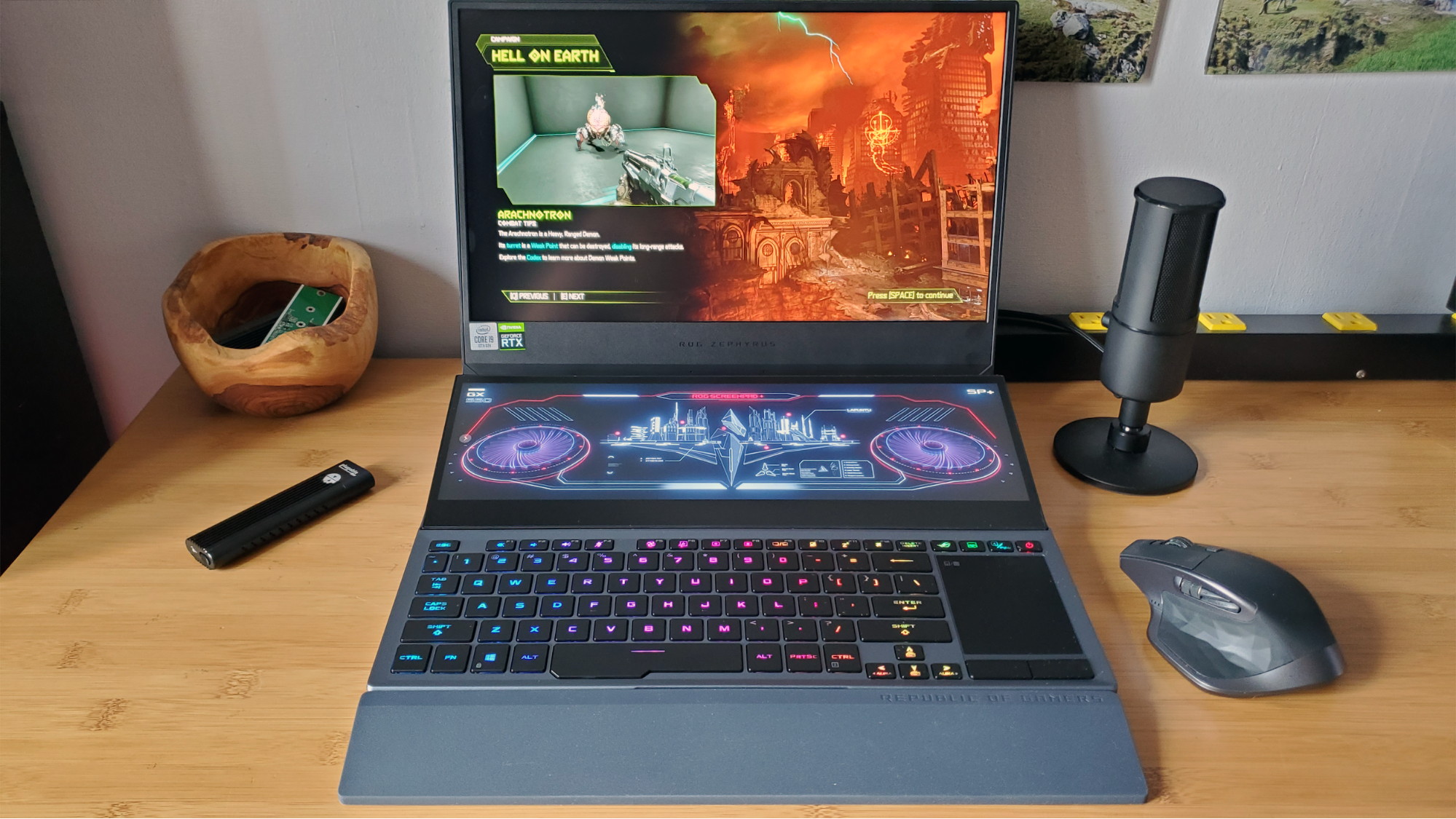
Whether you want to take your rig on the road, carry it to the couch, or just save space on your desk, a gaming laptop packs PC graphics performance into a compact, portable form factor. The market is loaded with choices that come with screens ranging from 14 to 18 inches (with great options like the Asus ROG G16 landing comfortably in the middle), graphics cards that can handle a variety of resolutions and prices that start at less than $999 but creep over the $5,000 mark. The best gaming laptops often come with fancy RGB lights, high refresh rate panels and, sometimes, even mechanical keyboards.
To help you choose the right gaming laptop, we test many models each year, benchmarking them in popular games like Cyberpunk 2077, Red Dead Redemption 2, Borderlands 3. We also measure the color gamut and brightness of their screens, determine battery life, and, of course, play games with them. Below, we’ve listed the best gaming laptops for various sizes, price points, and use cases. For those on a tight gaming budget, we also have dedicated pages for the best gaming laptops under $1,500 and the best gaming laptops under $1,000.
We've started testing the latest components for 2025, including Intel's latest Core Ultra CPUs and Nvidia's "Blackwell" mobile GPUs. While we're always excited for the next generation of gaming notebooks, those RTX 50-series GPUs haven't made our list yet. Our review of the Razer Blade 16 revealed some driver issues that we're waiting for Nvidia to fix. We're testing more and hope to see those updated soon so that we can add more new picks to this page.
We're also seeing a renaissance in integrated graphics, which might lead some companies to see how far they can push systems without discrete GPUs altogether. That means over the next few months, we should see a bunch of refreshed gaming laptops for playing on the go.
The quick list

The Best Gaming Laptop
MSI's flagship gaming laptop has a gorgeous 18-inch Mini-LED display, an RGB touchpad, and a mechanical keyboard. For gaming, it's powered by an Intel Core i9-14900HX and Nvidia GeForce RTX 4090 Laptop GPU, plus luxurious amounts of RAM and storage. The downside? It's $5,399.99, putting it out of reach for most.
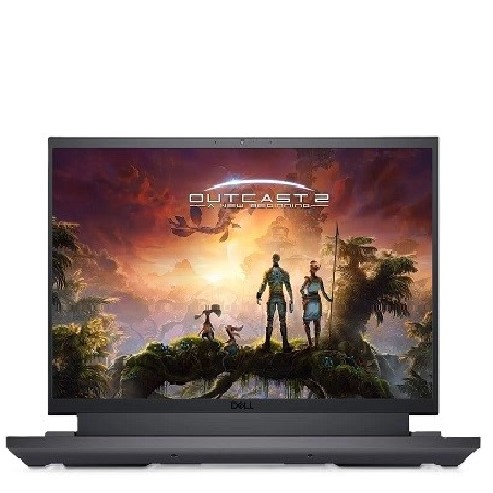
Best Budget Gaming Laptop
The Dell G16 (7630) stands out for strong configuration options below $1,000. The combination of an Intel Core i7 and Nvidia RTX 4060, as well as a mechanical keyboard, is a surprise at this price point, even though the machine is still clunky and made of plastic.
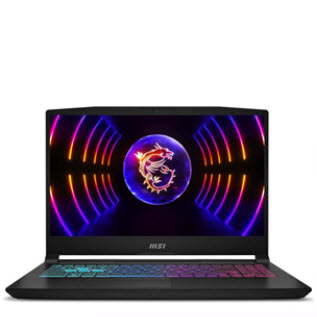
Best Budget Gaming Laptop Alternative
The $999 model features a Core i7-13620H and Nvidia GeForce RTX 4050 and offers strong 1080p performance. It includes 16GB of RAM and 1TB of storage, which is nice to see, as those are often some of the first specs to get cut for a budget PC. Its 144 Hz refresh rate will be a boon for esports players. We also appreciate the quality of the speakers for the price.
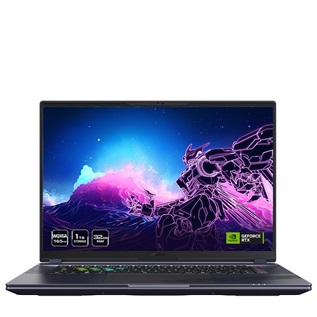
Mid-range value
If you find this model on sale as we did at $1,599, you get great specs for the price, including an Intel Core i7-14650HX, Nvidia GeForce RTX 4070 Laptop GPU, 32GB of RAM, and 1TB of storage. It's enough to power the laptop's very pretty 2560 x 1600 display.

Best 14-inch Laptop
Asus' TUF Gaming A14 feels premium, looks grown-up, and delivers great battery life for non-gaming tasks. For truly portable gaming, this AMD and Nvidia-based pick is a strong choice.

Best Thin and Light Gaming Laptop
The Asus ROG Strix G16 is catching up to Razer in powerful, portable gaming laptops well. The Strix G16's Core i9-13980HX and Nvidia GeForce RTX 4070 provided great performance in a 0.89-inch thick chassis. Is the design as sleek as Razer's Blades? No, but at $1,999.99 when we tested it, Asus is also competing on price.
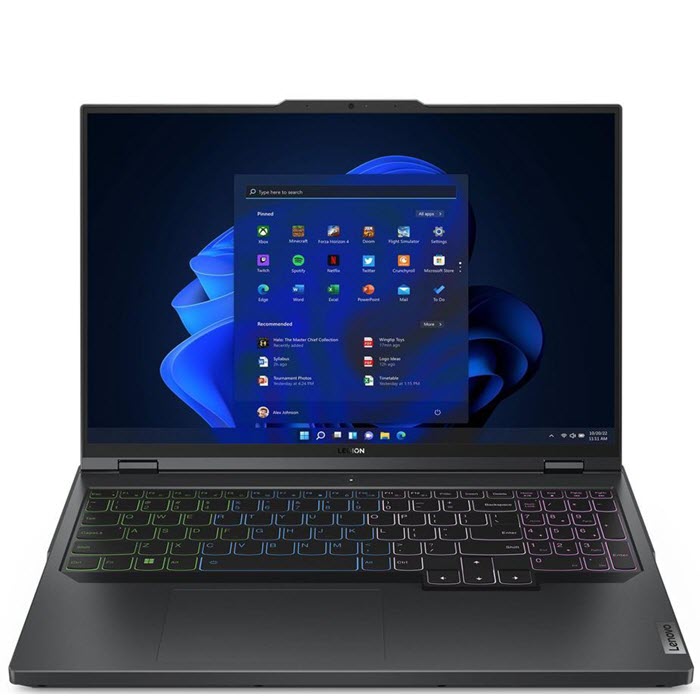
Best Esports Machine
Sometimes you want to run your games fast, and sometimes you prioritize making them look great. The Lenovo Legion Pro 5i splits the difference, with a 2560 x 1600 screen that goes up to 165 Hz, allowing for both quick-twitch esports alongside immersive action games. The fact that you can get it for under $1,500 sure doesn't hurt, and the gaming performance with an RTX 4060 is solid.

With strong build quality and powerful performance, the Alienware m18 R2 makes a strong case if you're using it to replace a desktop. We appreciate its plethora of upgradeable parts, including room for a ton of M.2 SSDs. The Cherry keyboard option is excellent and well worth the extra cost.
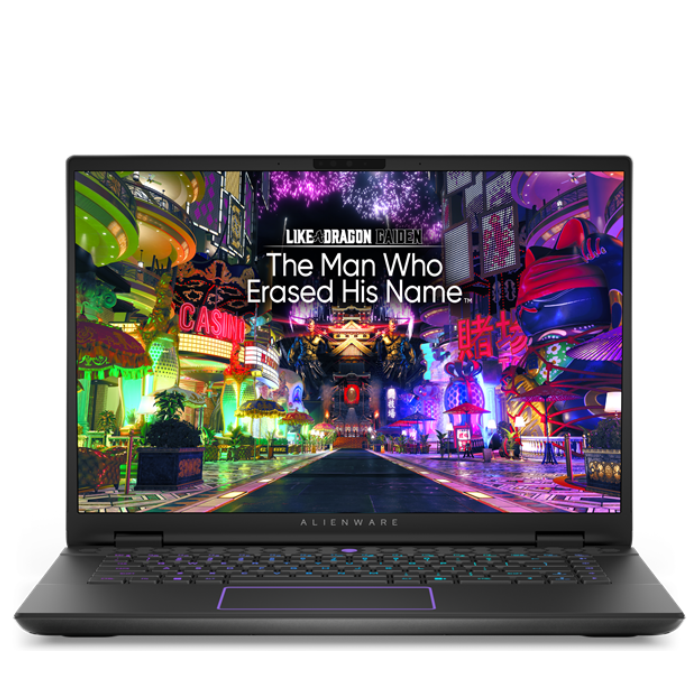
Best Crossover Productivity/Gaming Laptop
Think of the Aliewnare m16 R2 as a crossover laptop. It's got gaming-grade components, but it's styled to look a bit more like a productivity-focused machine, with strong build quality and sleek looks. We loved the keyboard and touchpad for work, and the gaming performance here delivered for play.
Best Gaming Laptops 2025
Why you can trust Tom's Hardware
The Best Gaming Laptop
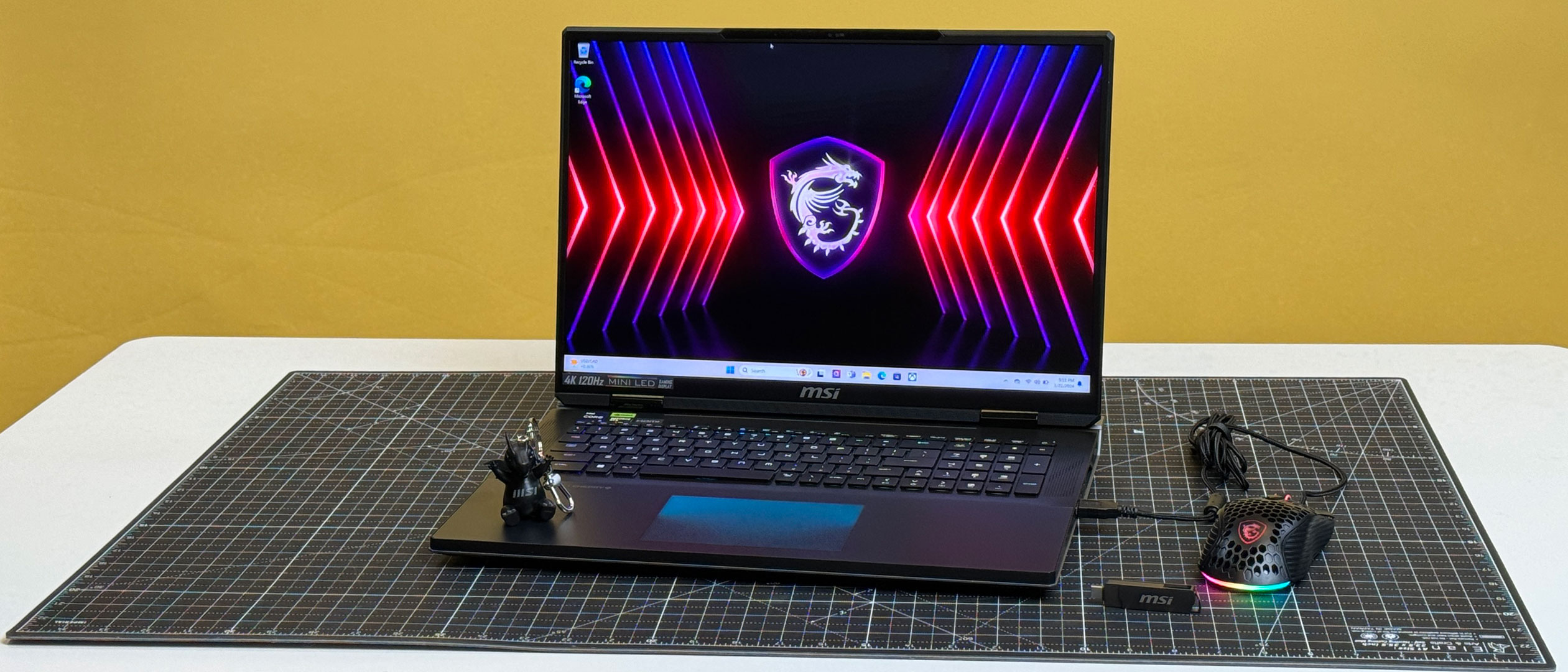
Specifications
Reasons to buy
Reasons to avoid
The MSI Titan GT77 HX has everything, and, we'll be honest, it should. We tested it at $5,399.99, which is way out of reach for most people (don't worry, there are cheaper options further down the list). Between powerful performance, an excellent 18-inch mini-LED screen, and a clicky, mechanical keyboard, there's a lot to enjoy here.
The Intel Core i9-14900HX and Nvidia GeForce RTX 4090 Laptop GPU are powerful, though they admittedly don't offer a huge bump over previous generations. But with 128GB of RAM and 4TB of SSD storage there's plenty of room for games and more memory than you'll ever need for gaming. This would be a great machine for video editors.
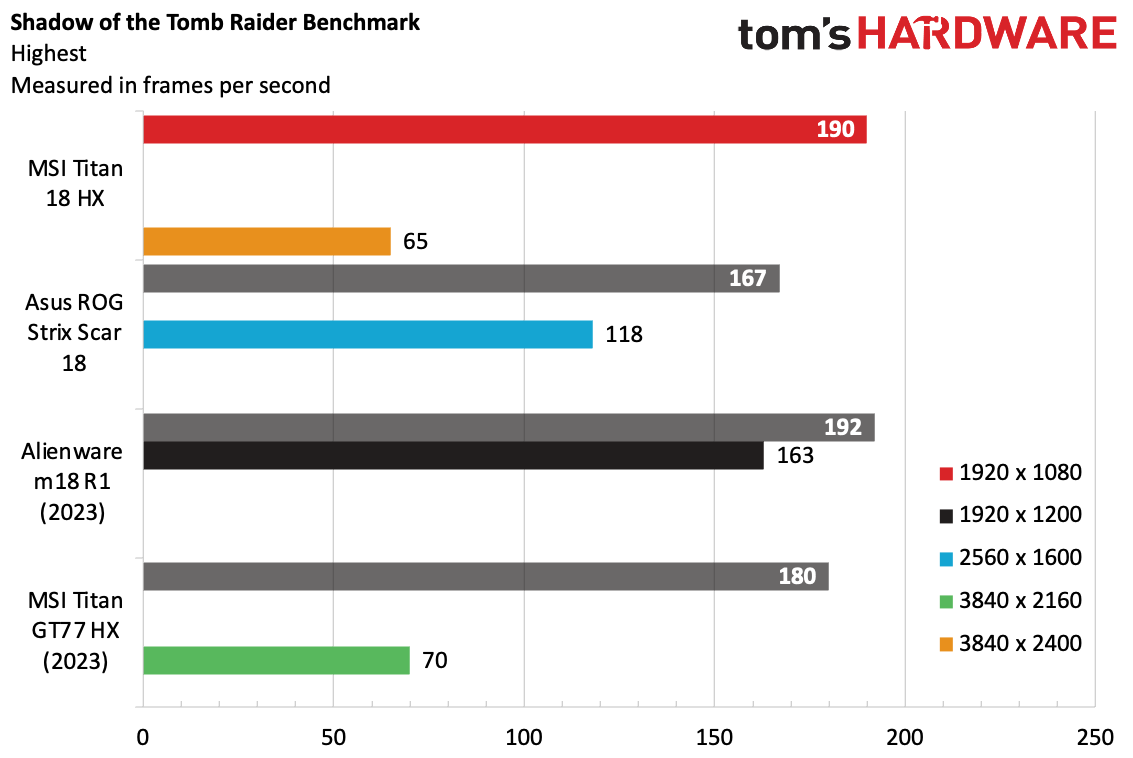
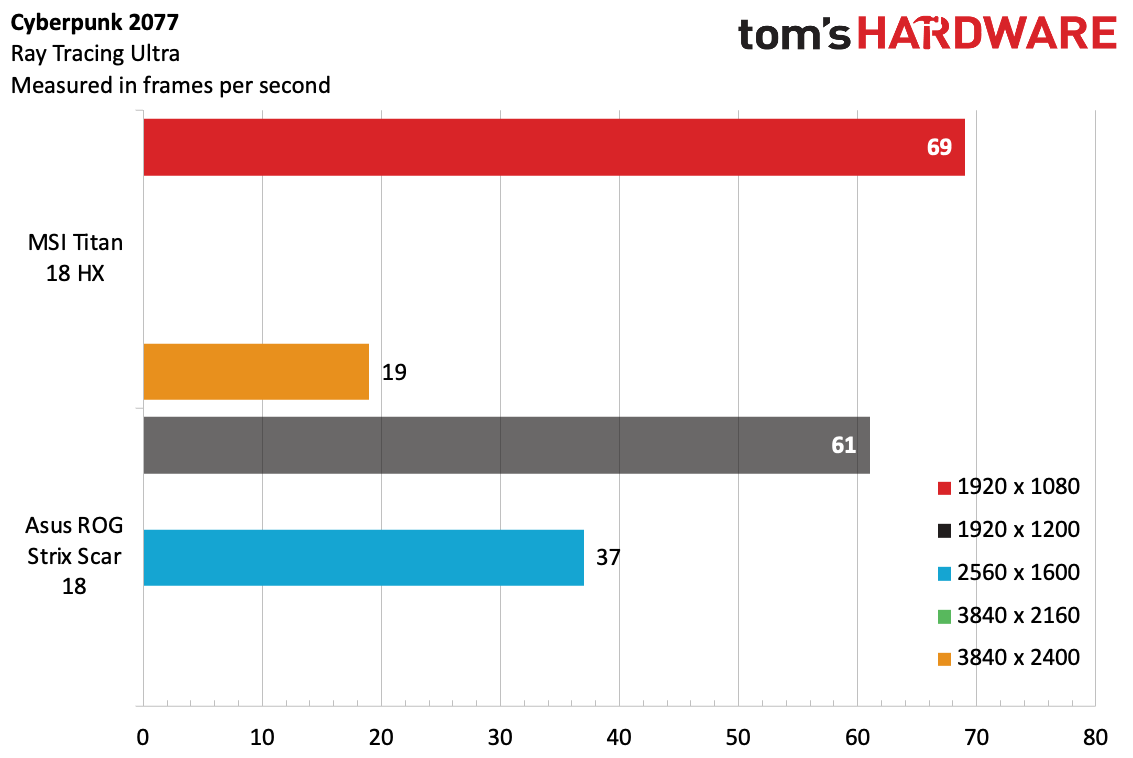
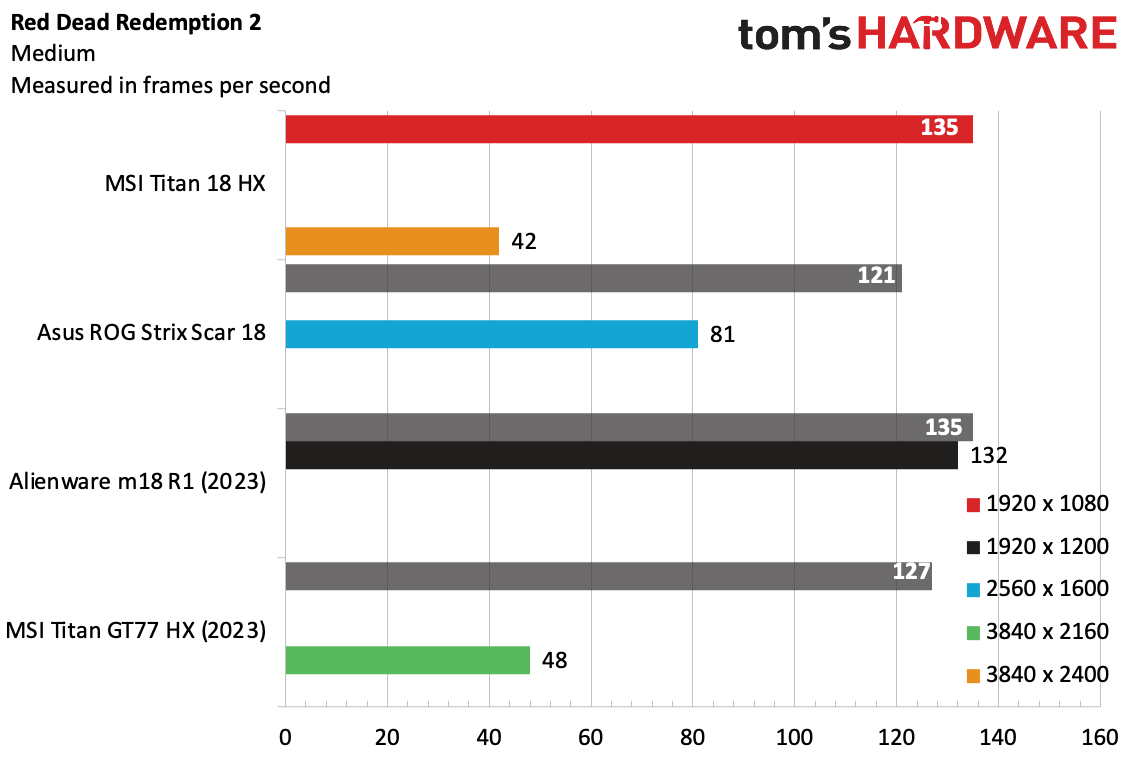
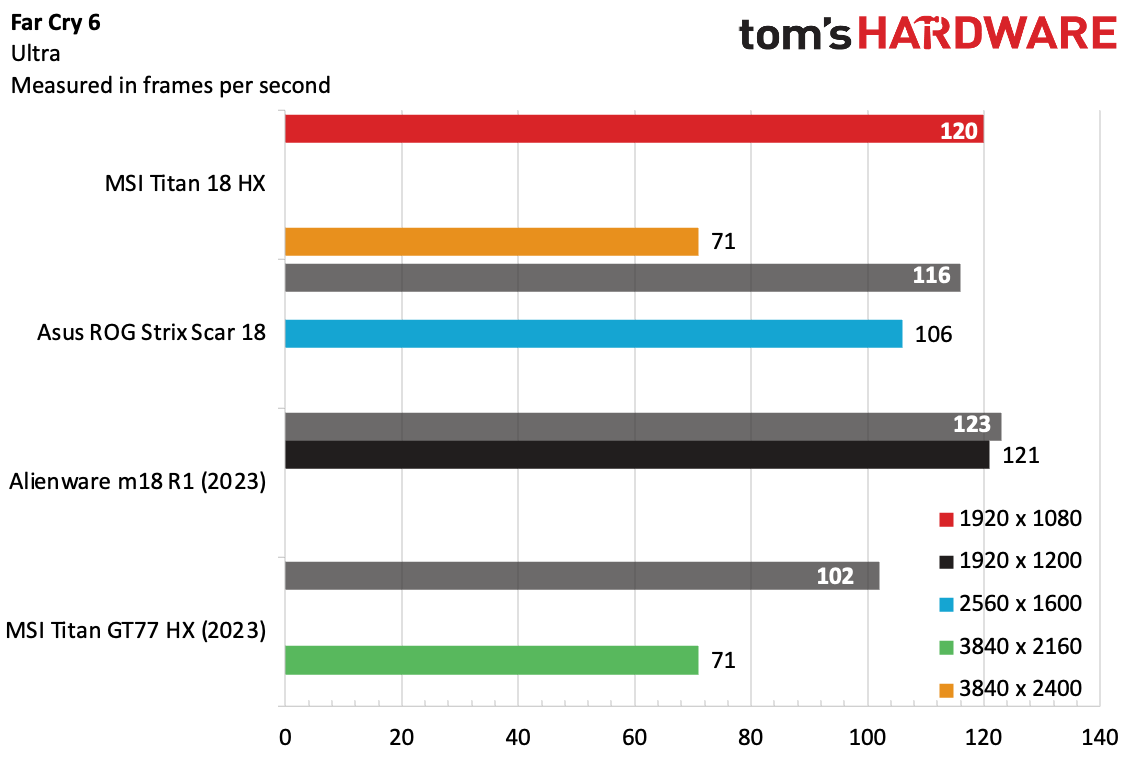
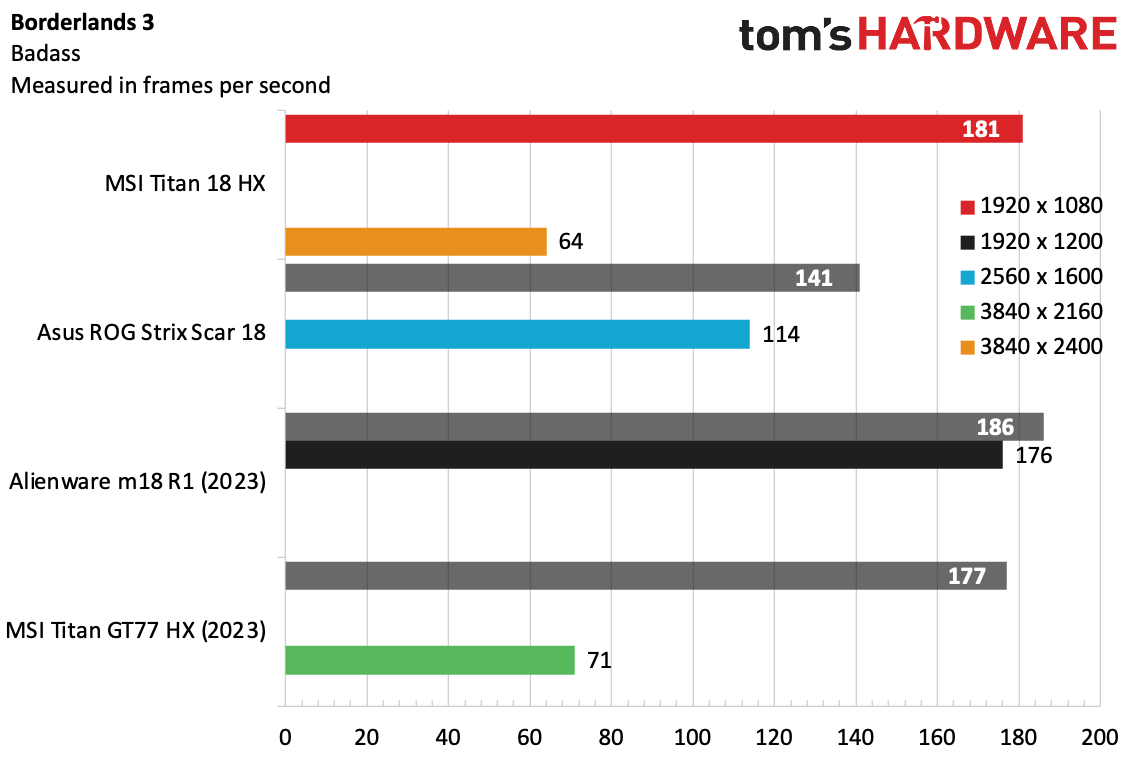
Admittedly, the 14th Gen Intel Core processor doesn't have any huge performance gains over 13th Gen Core gaming laptops, but the Titan 18 HX did great in some of our most difficult tests, like running Cyberpunk 2077 on the Ray Tracing Ultra preset.
MSI is using a Cherry MX mechanical keyboard, which is clicky and comfortable. It's a luxury for typing and gaming, though it's unfortunate that MSI doesn't also use these switches for the number and arrow keys.
But the highlight is the 18-inch, mini-LED display, which covered 112.4% of the DCI-P3 color gamut in our testing and measured an incredibly bright 559 nits with our light meter. Games and movies look excellent on this HDR display.
With the Titan, MSI has come as close to cramming a desktop into a laptop chassis as possible. It's for people who don't have room for — or don't want — a desktop. It's the best in many ways, assuming you can afford it.
Read: MSI Titan 18 HX review
The Best Budget Gaming Laptop
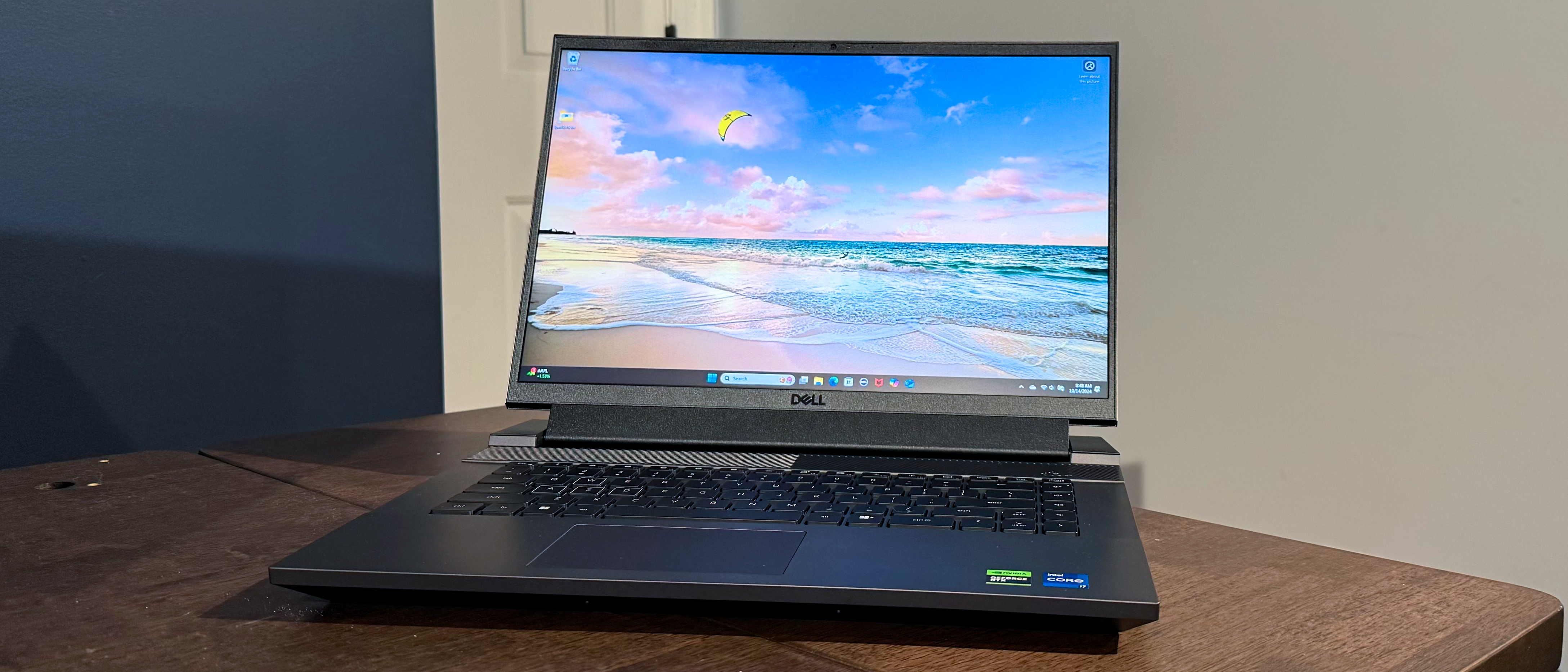
Specifications
Reasons to buy
Reasons to avoid
With few laptops starting under $1,000 these days, the best gear for a budget is often a little older. But the Dell G16 (7630), now regularly in that budget price rice range, provides some niceties that other companies don't.
Most gaming laptops at this price have an RTX 4050, but the RTX 4060 in the G16 makes for far stronger gaming performance. And the fact that Dell included a Cherry MX mechanical keyboard, often found in more premium Alienware-branded laptops, is icing on the cake. There's also a 16-inch screen that goes up to a 240 Hz refresh rate for quick-twitch esports.
Like most budget machines, it's a little bulky and doesn't have all of the most modern features (this, for instance, has a 720p webcam). But the power you get for the performance is hard to ignore.
Read: Dell G16 (7630) review
Best Budget Alternative
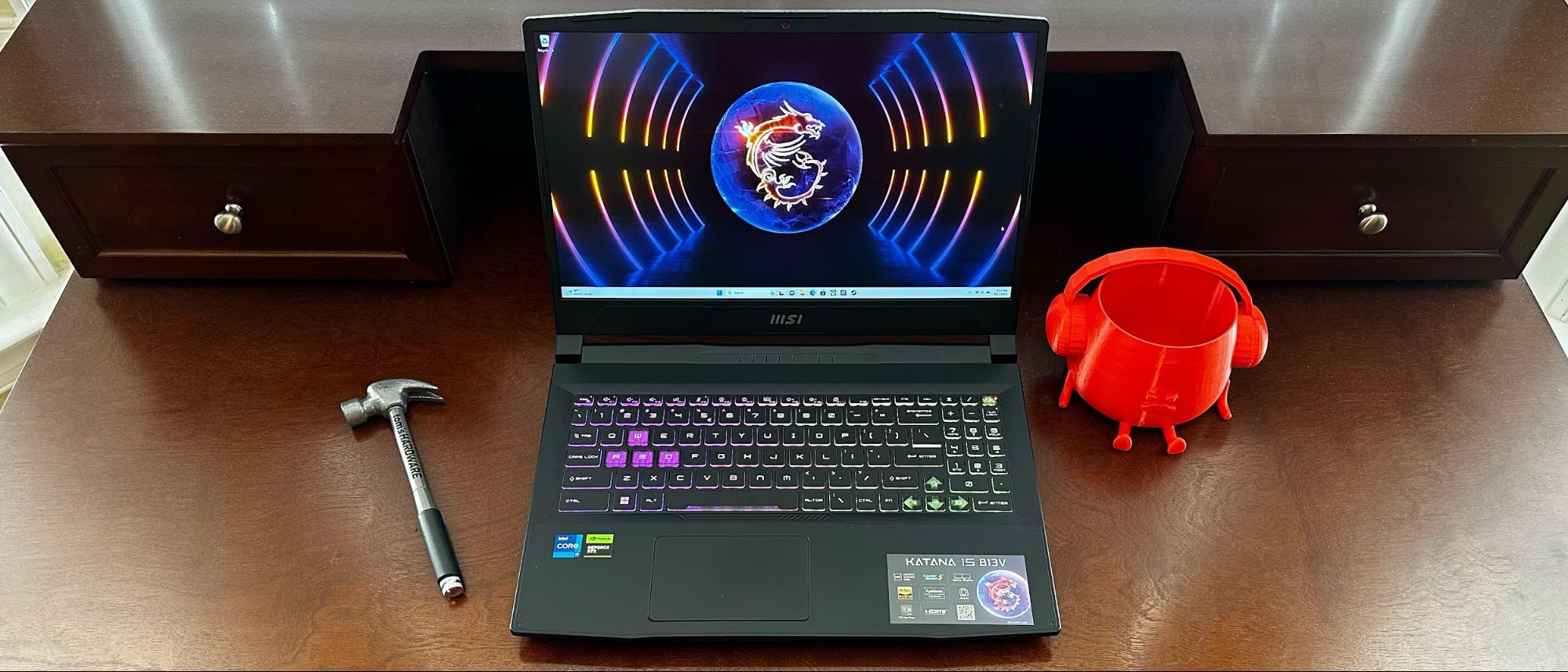
Specifications
Reasons to buy
Reasons to avoid
The MSI Katana 15 is among our favorite gaming laptops for those with just $1,000 to spend. We tested a $999 model with a Core i7-13620H and Nvidia GeForce RTX 4050 offering strong 1080p performance, though you may have to turn down some settings in some games.
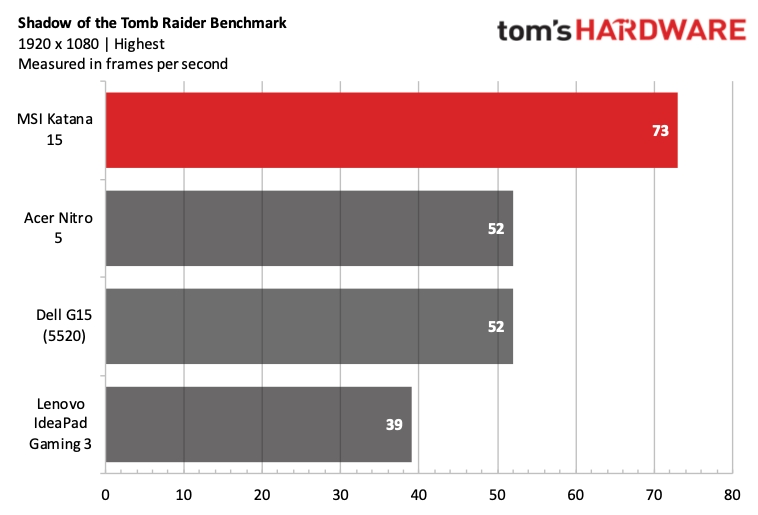
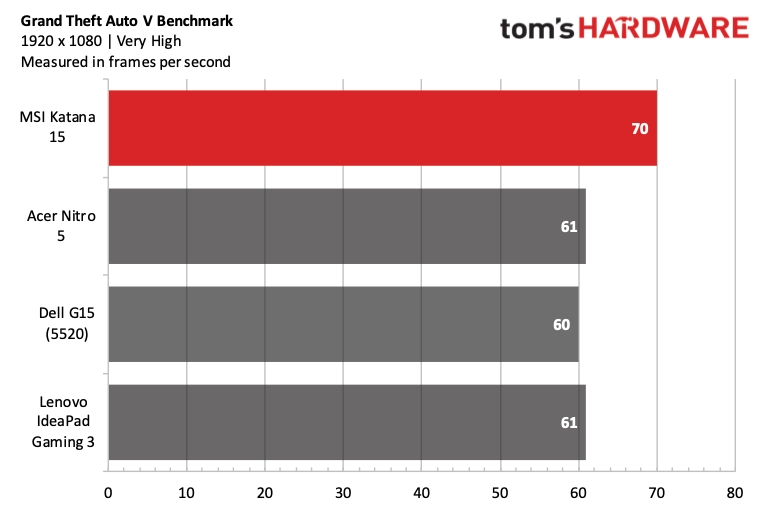
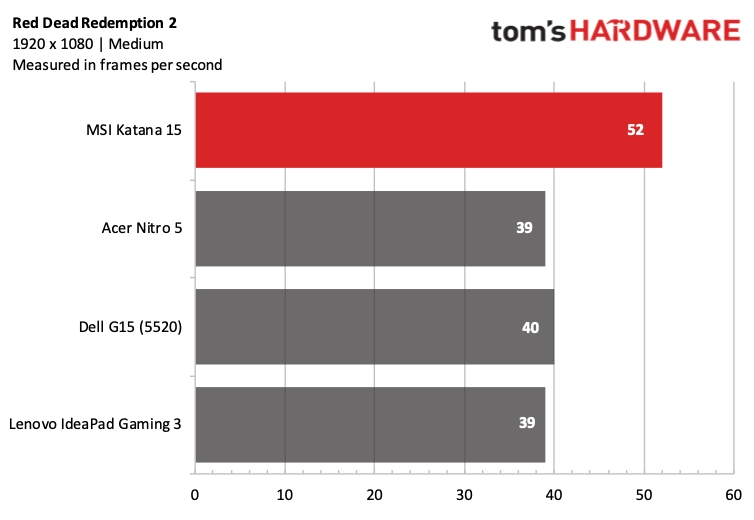
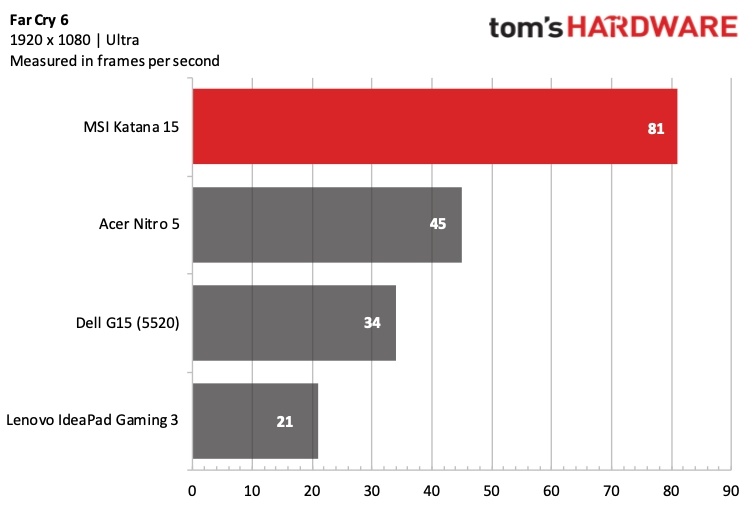
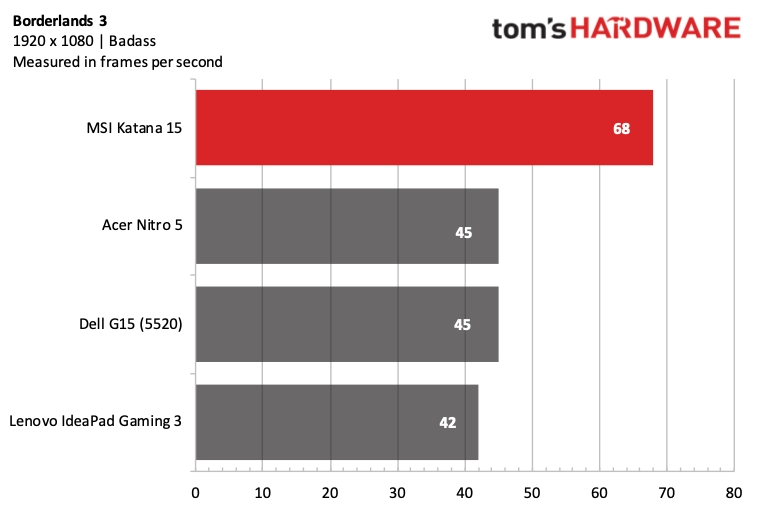
In our testing, the Katana passed 60 fps in most benchmarks at some pretty high settings, though some, like Red Dead Redemption 2, were run lower. As games get more challenging, budget laptops won't run at the highest settings for long.
Even under $1,000, you get 16GB of RAM and 1TB of storage, which is nice to see, as those are often some of the first specs to get cut for a budget PC. Instead, the chassis is made of cheap plastic, but the internals should get the job done.
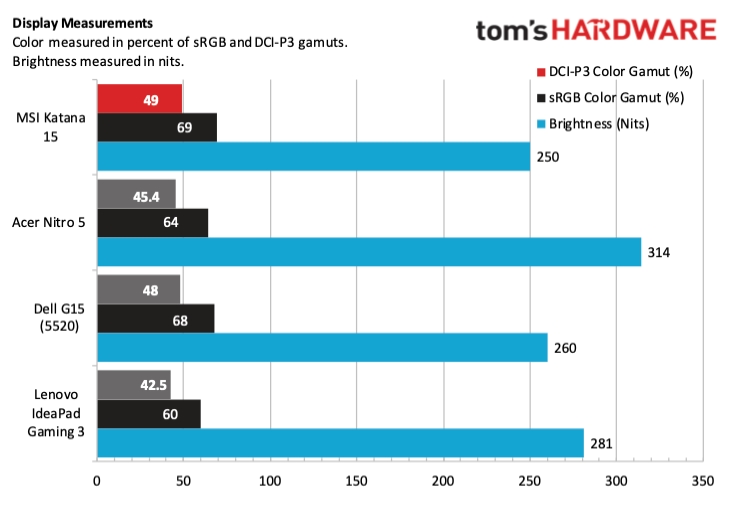
The display could be a bit more vivid, but its 144 Hz refresh rate will be a boon for esports players. And for its price, it delivers solid audio.
Read: MSI Katana 15 Review
Mid-range value
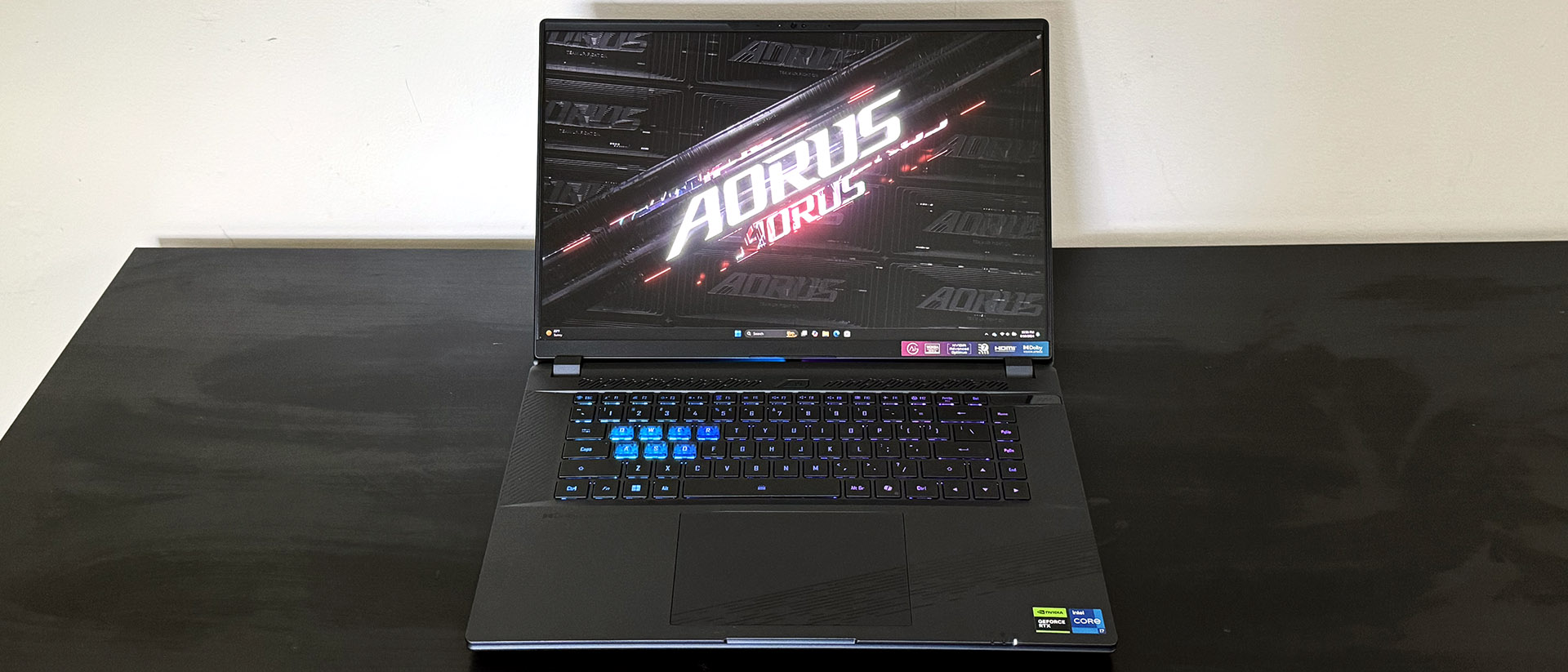
Specifications
Reasons to buy
Reasons to avoid
At $1,599.99 as tested, the Gigabyte Aorus 16X packs a lot of features into its 16-inch frame.
The laptop has a vibrant, 2560 x 1600 display that runs at 165 Hz for smooth first person shooters and esports. Its Core i7-14650HX CPU and GeForce RTX 4070 graphics card effortlessly handle games on the great display, and its built-in speakers are good enough that in a pinch, you won't have to worry about headphones.
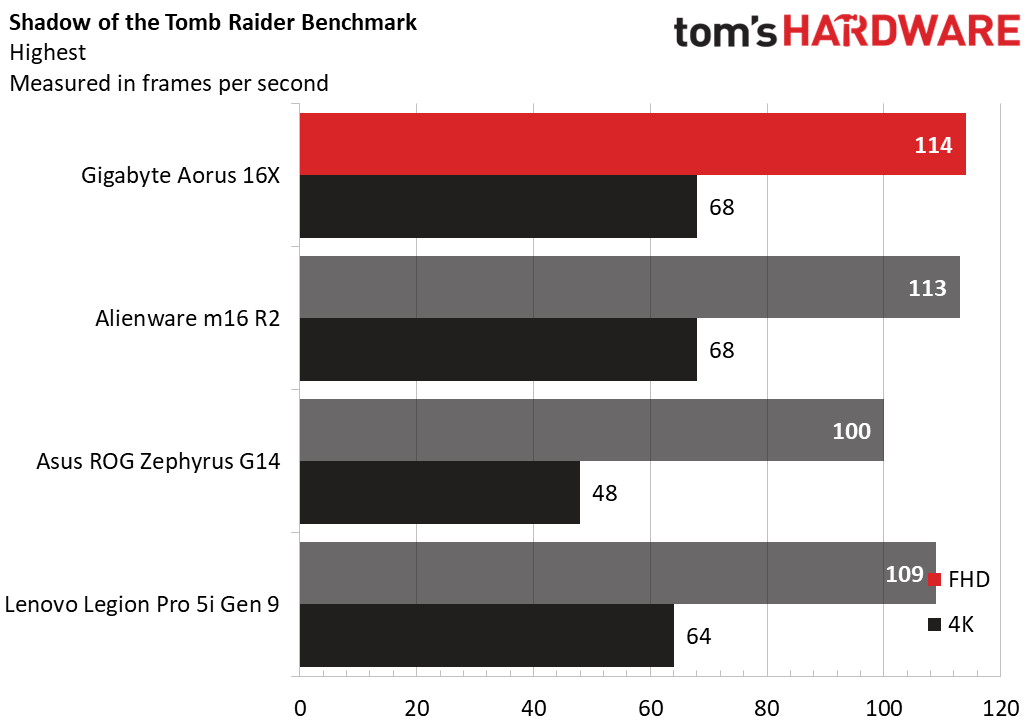
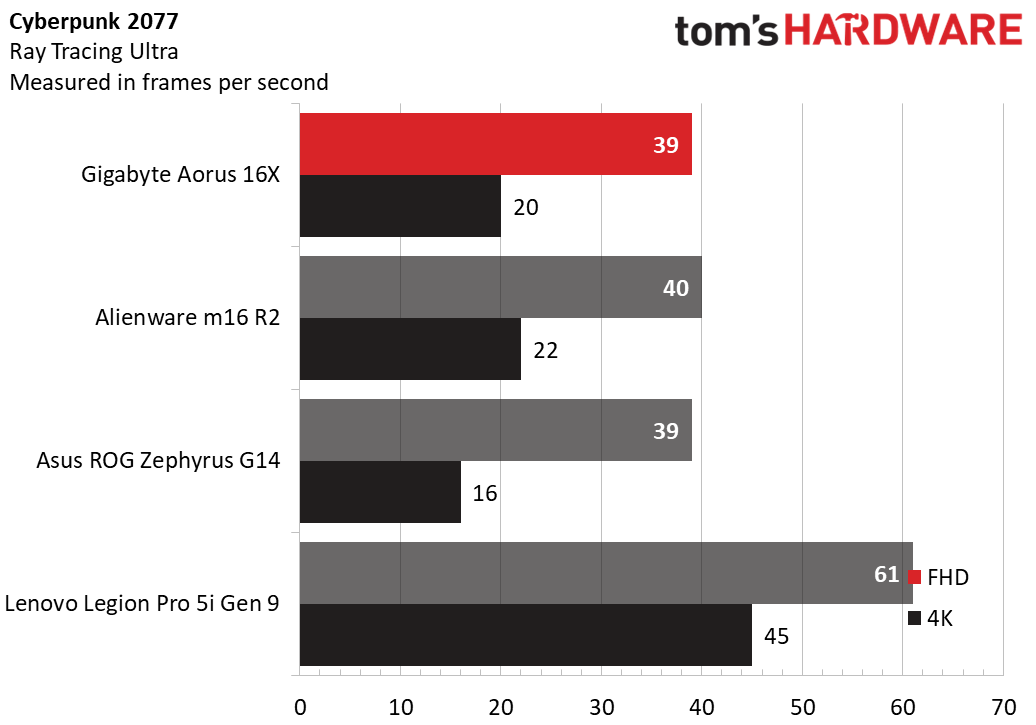
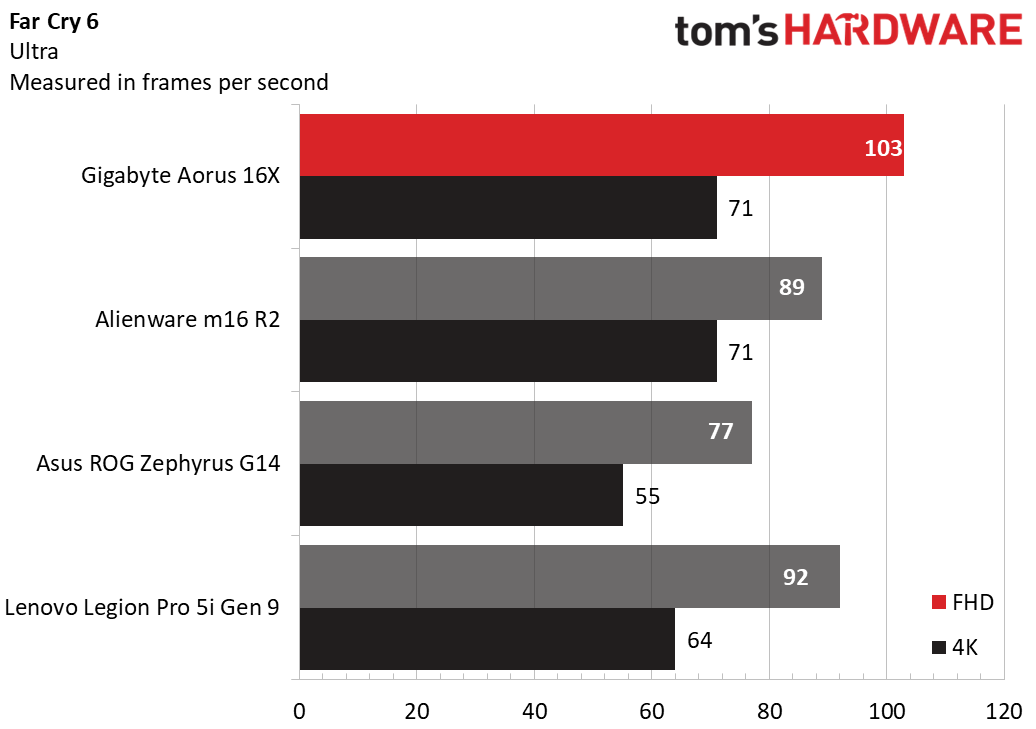
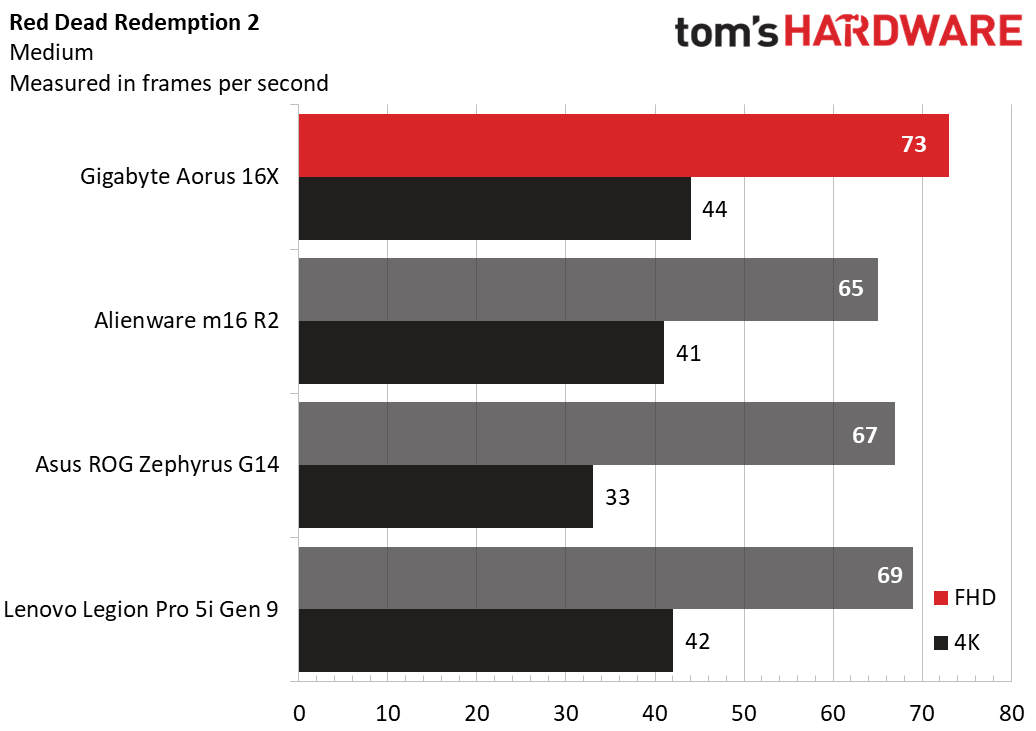

On the practical side, it has productive input devices, excellent connectivity (including Thunderbolt 4 and Wi-Fi 7), and biometric security from its IR webcam. A surprising number of midrange gaming notebooks forego biometrics, so it's nice to have these security features.
You'll still want to carry a charger around, and Gigabyte's software isn't exactly the most intuitive. But if you want powerful gaming on a nice screen for a decent price, it's hard to argue with what's being offered here.
Read: Gigabyte Aorus 16X review
Best 14-inch Laptop
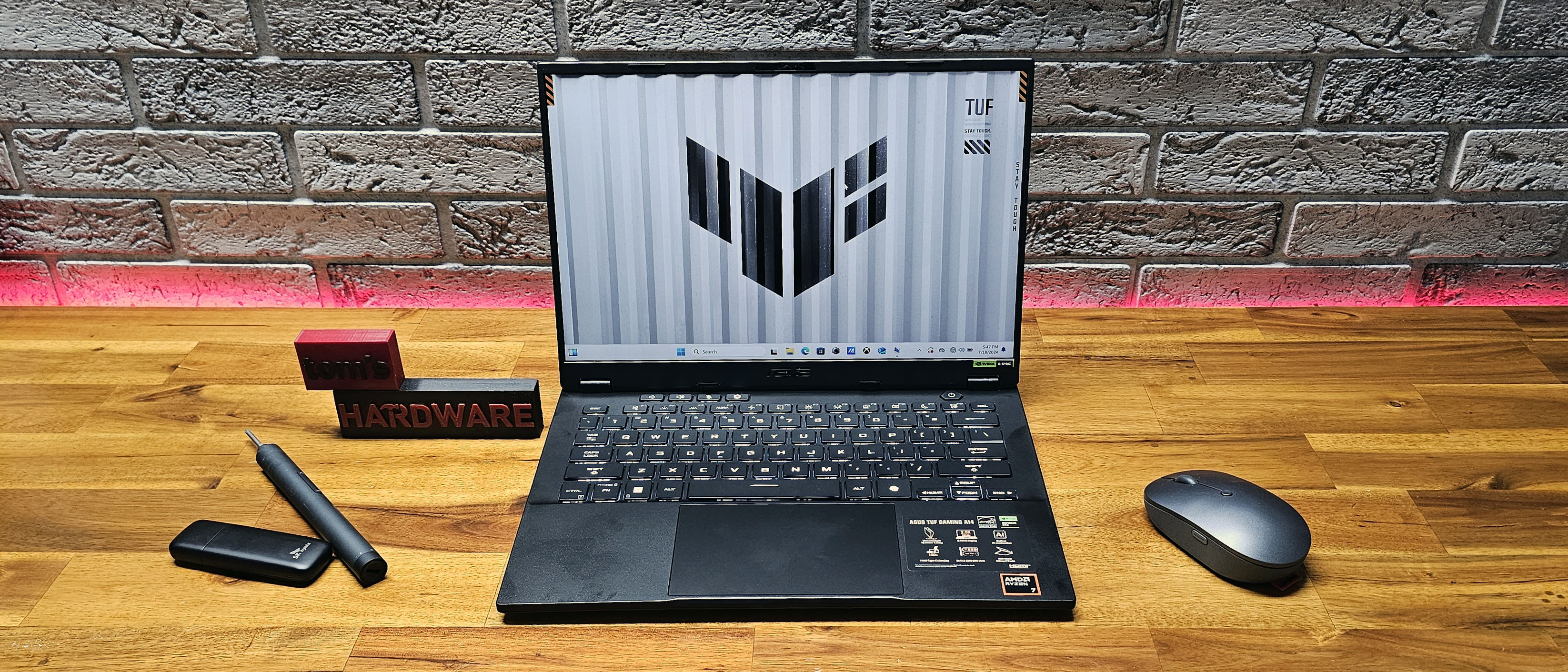
Specifications
Reasons to buy
Reasons to avoid
While Asus has often treated its TUF Gaming brand as a budget lineup, the A14 sure feels premium. In fact, it's our favorite 14-inch laptop we've recently tested, standing out in a suddenly crowded category.
It's understated design seems to borrow from the more upscale Zephyrus lineup. Despite packing an RTX 4060 in our review configuration, the TUF is just 3.22 pounds and 0.78 inches thick, putting it in line with some ultrabooks.
When we weren't using it for gaming, the A14 used Nvidia's Advanced Optimus and switched to the integrated graphics, managing to squeeze out 10 hours and 4 minutes of life on our battery test, which involves web browsing, streaming, and browser-based graphics tests.
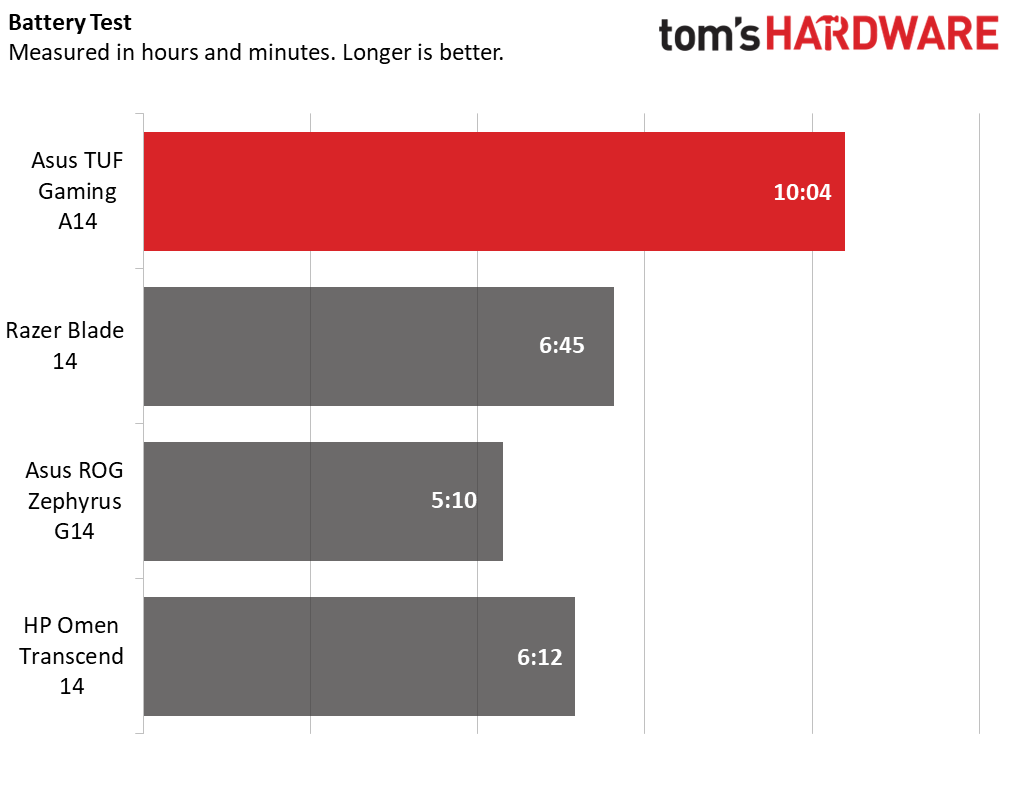
The speakers are a bit quiet, but we appreciated the travel-friendly design. The 100W RTX 4060 can only play games at moderate settings, but if you're on the go, the A14 is a great option.
Read: Asus TUF Gaming A14 review: Understated endurance
Best Thin and Light Gaming Laptop
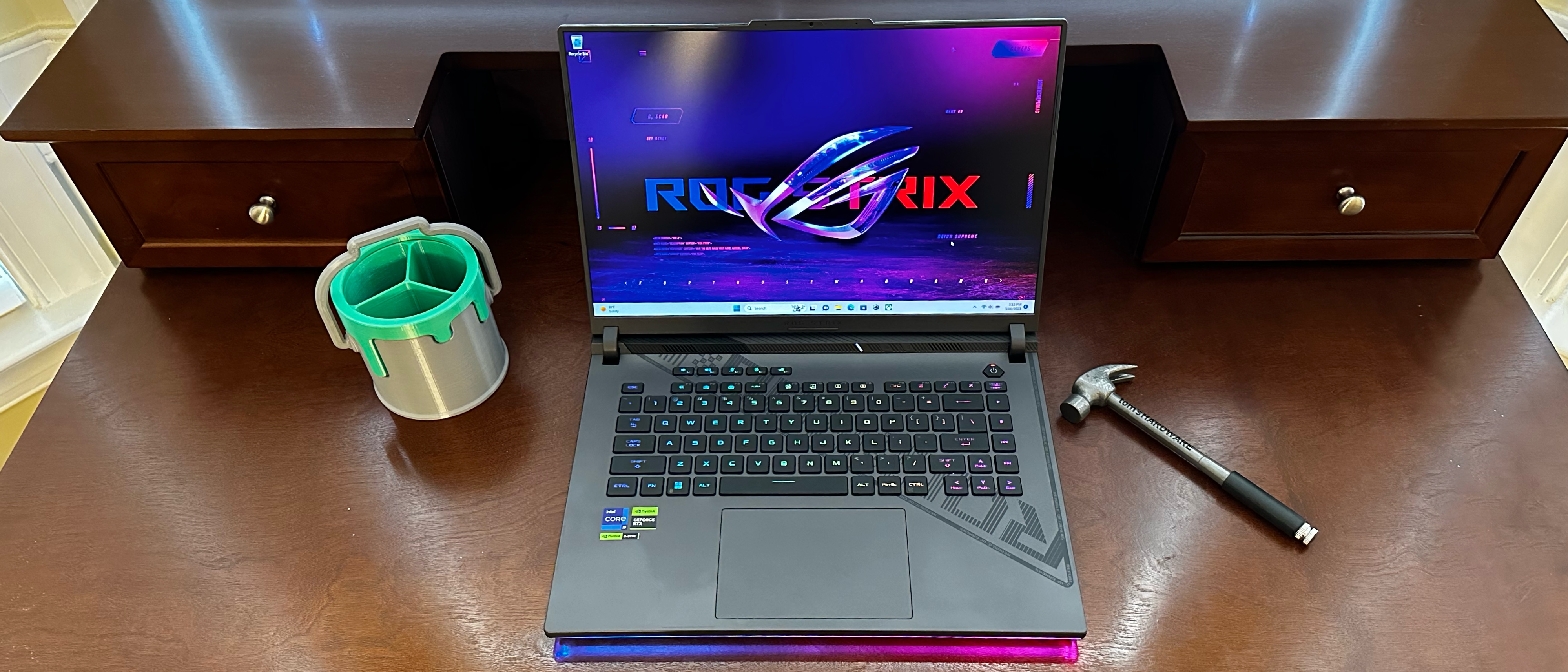
Specifications
Reasons to buy
Reasons to avoid
The Asus ROG Strix G16 is catching up to Razer in powerful, portable gaming laptops well. The Strix G16's Core i9-13980HX and Nvidia GeForce RTX 4070 provided great performance in a 0.89-inch thick chassis. Is the design as sleek as Razer's Blades? No, but at $1,999.99 when we tested it, Asus is also competing on price.
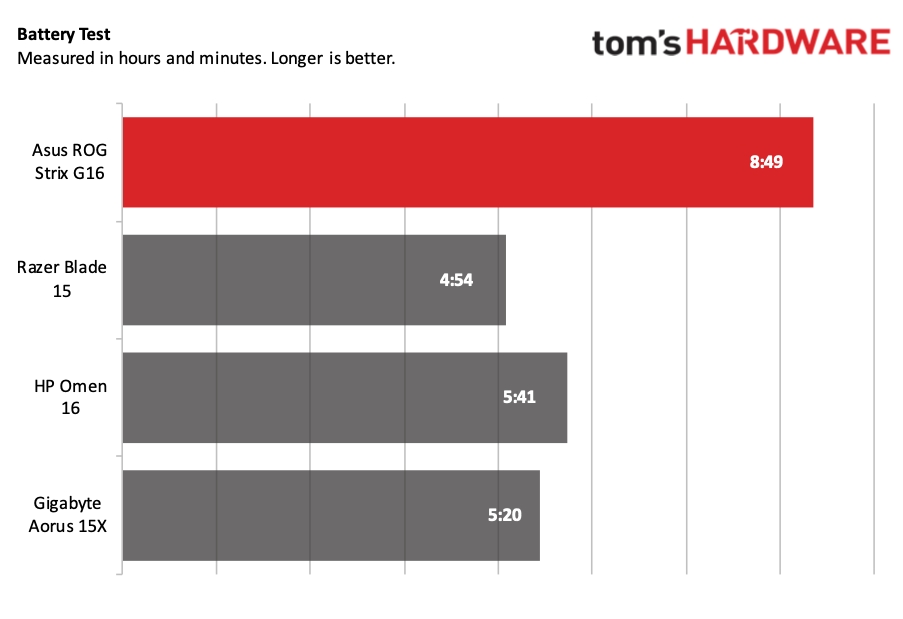
We also appreciated the Strix's battery life — it lasted for 8 hours and 49 minutes on our battery test, as well as the RGB keys with 2 millimeters of travel.
The laptop's lid is aluminum, but the rest is plastic. In our time with the laptop, not once did we think the ROG Strix G16 felt cheap.
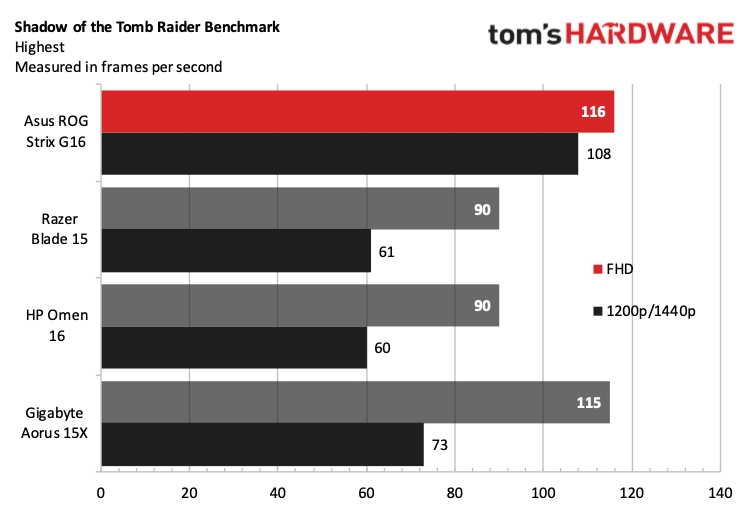
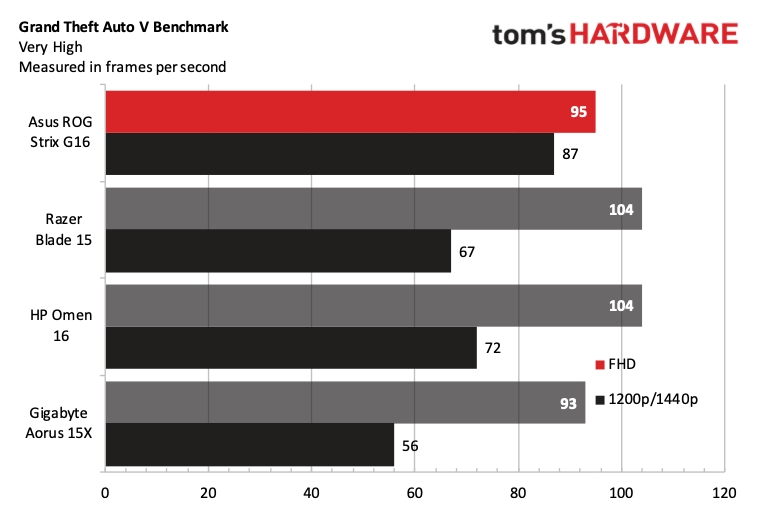
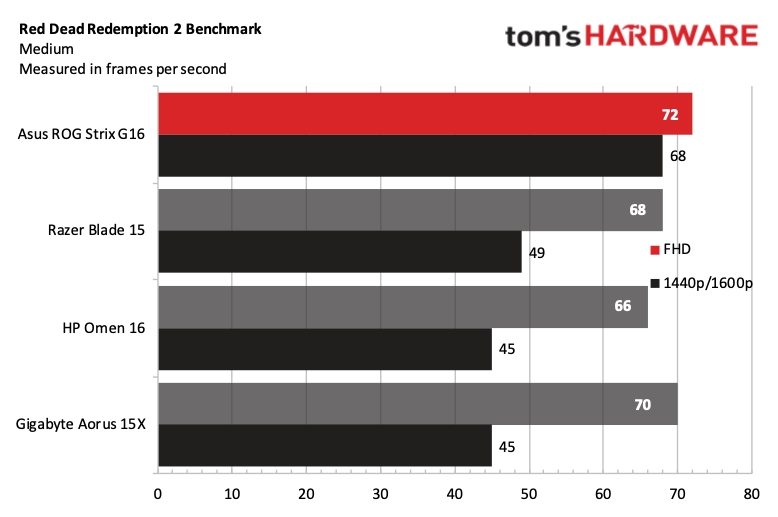
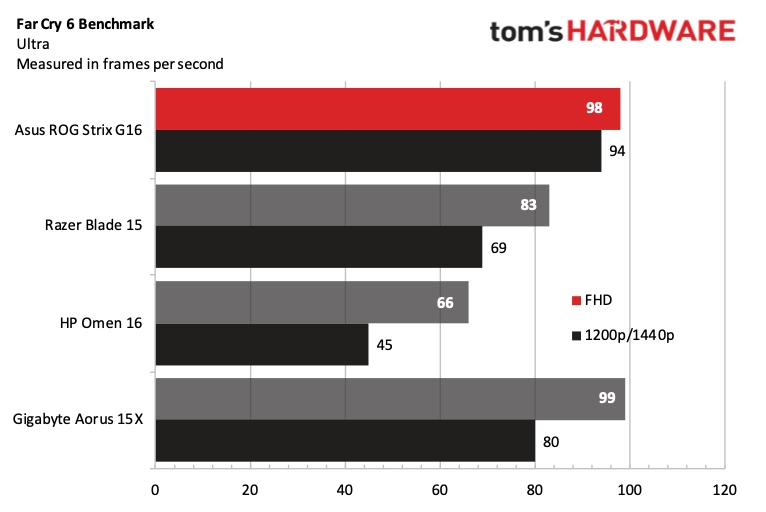
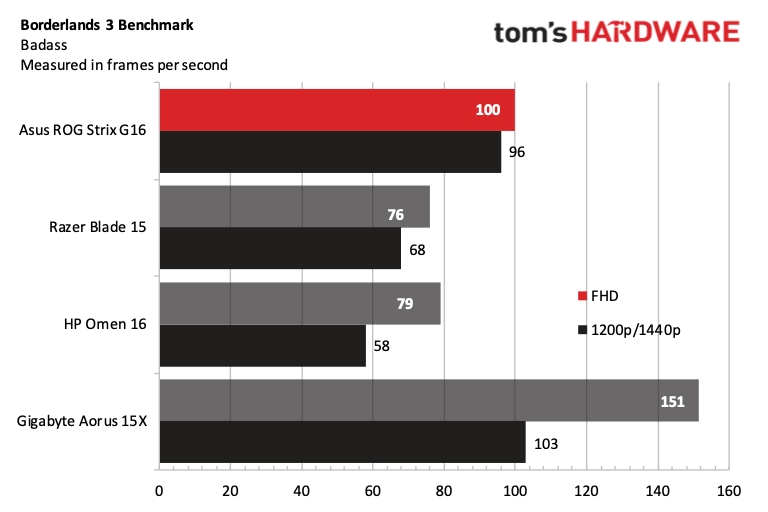
In fact, in each of the benchmarks we ran, the ROG Strix G16 surpassed 60 fps (often handily!), showing solid performance at both 1080p and its native 1920 x 200. Perhaps the biggest issue we had is that our unit had a 1920 x 1200 touch screen. The RTX 4070 should power that no problem based on our benchmarks, and in this price range you often see 1440p (or, in 16:10 screens like this one, 1600p) display panels.
Read: Asus ROG Strix G16 Review
Best 16-inch Esports Machine
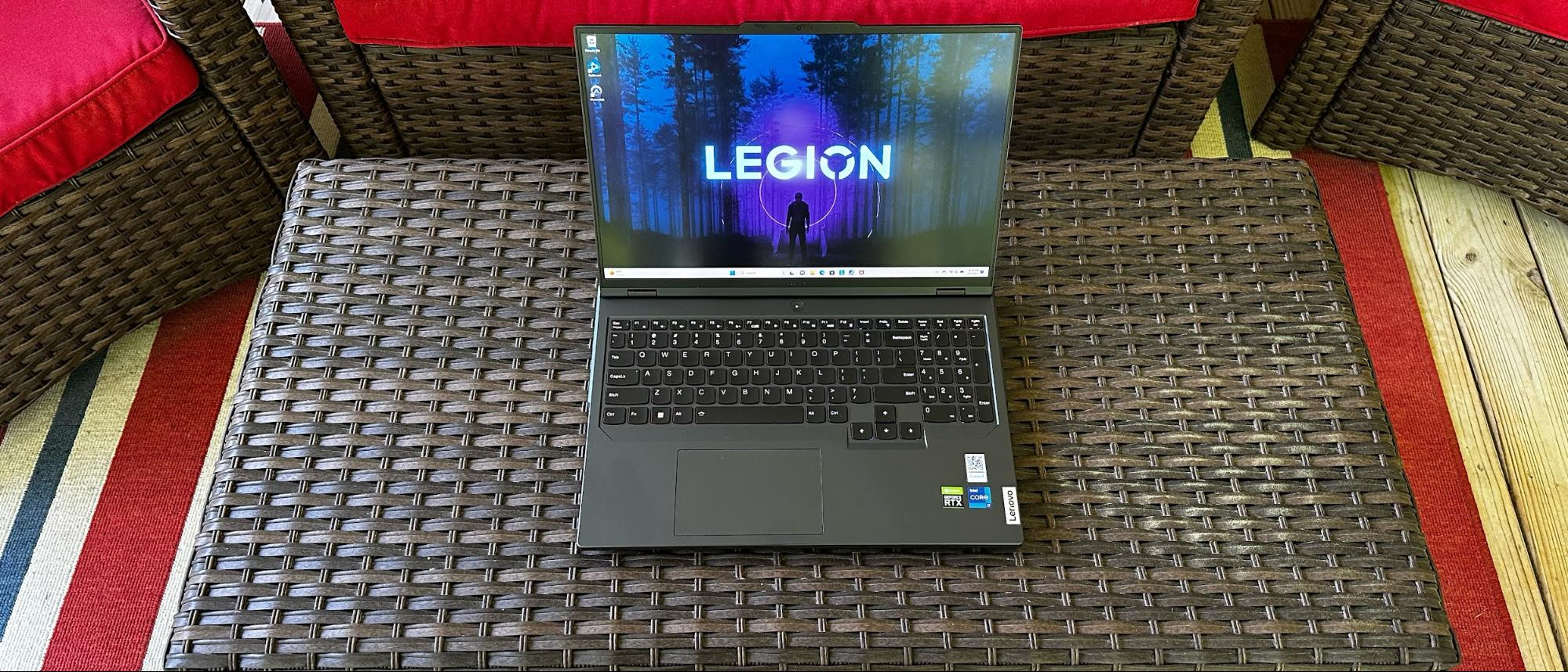
Specifications
Reasons to buy
Reasons to avoid
For under $1,500, you can get a 16-inch esports machine with a screen that also allows for high-resolution, intensive titles. The 2560 x 1600 display goes up to 165 Hz, which is fast enough for esports at 1080p, while the high resolution will make action games look great. Sure, some gaming laptops have faster displays, but they're often more expensive.
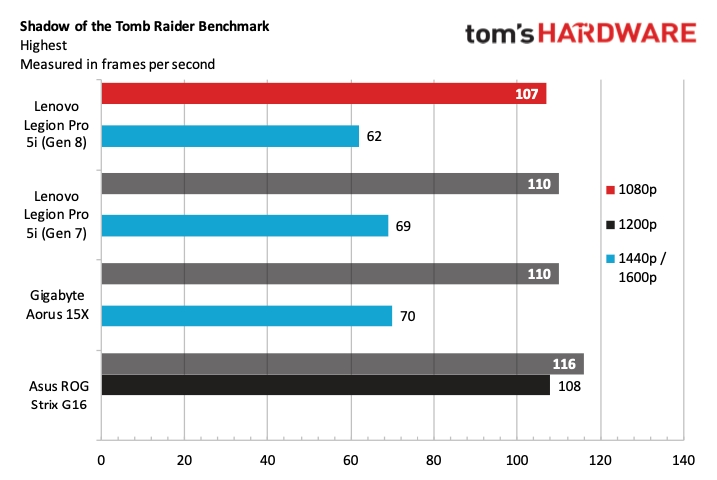
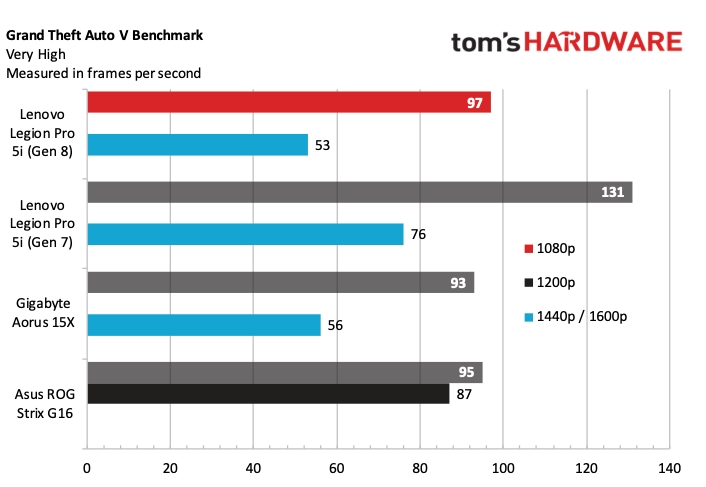
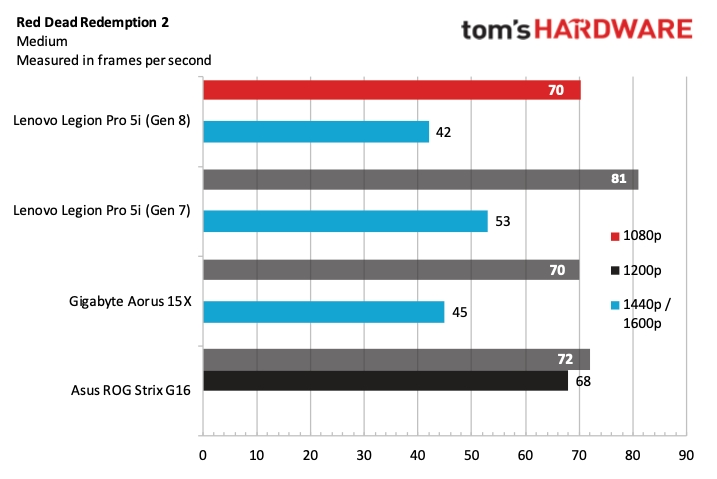
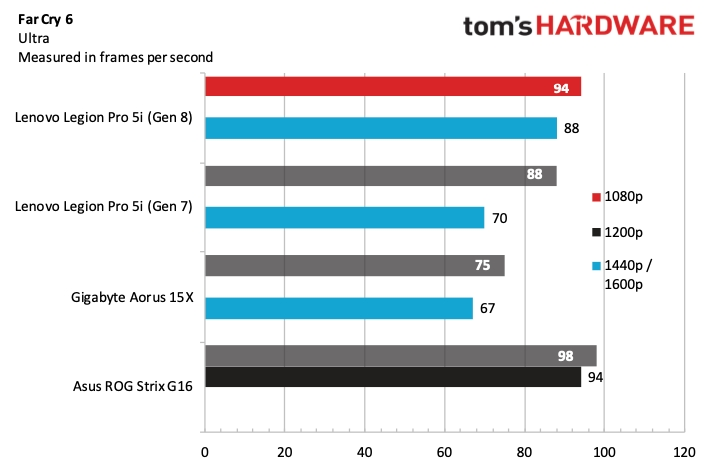
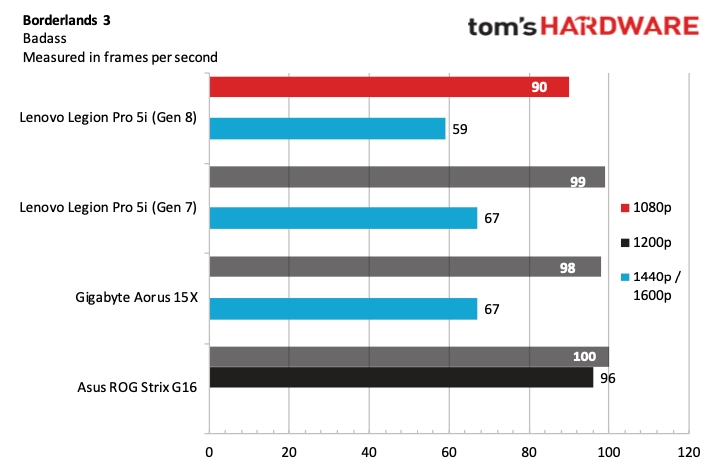
The "i" in 5i Pro stands for Intel. We tested with an Intel Core i7-13700HX along with Nvidia's GeForce RTX 4060. Our system also had 16GB of DDR5 RAM and a 512GB SSD.
This model has an improved 1080p webcam over previous generations, which is good for working as well as gaming. We found that its SSD was fast in our testing, and it offered competing gaming performance. That being said, you may want to consider one of the best gaming headsets because there's plenty of fan noise and the audio quality isn't the best.
Read: Lenovo Legion Pro 5i (Gen 8) Review
The Best Desktop Replacement
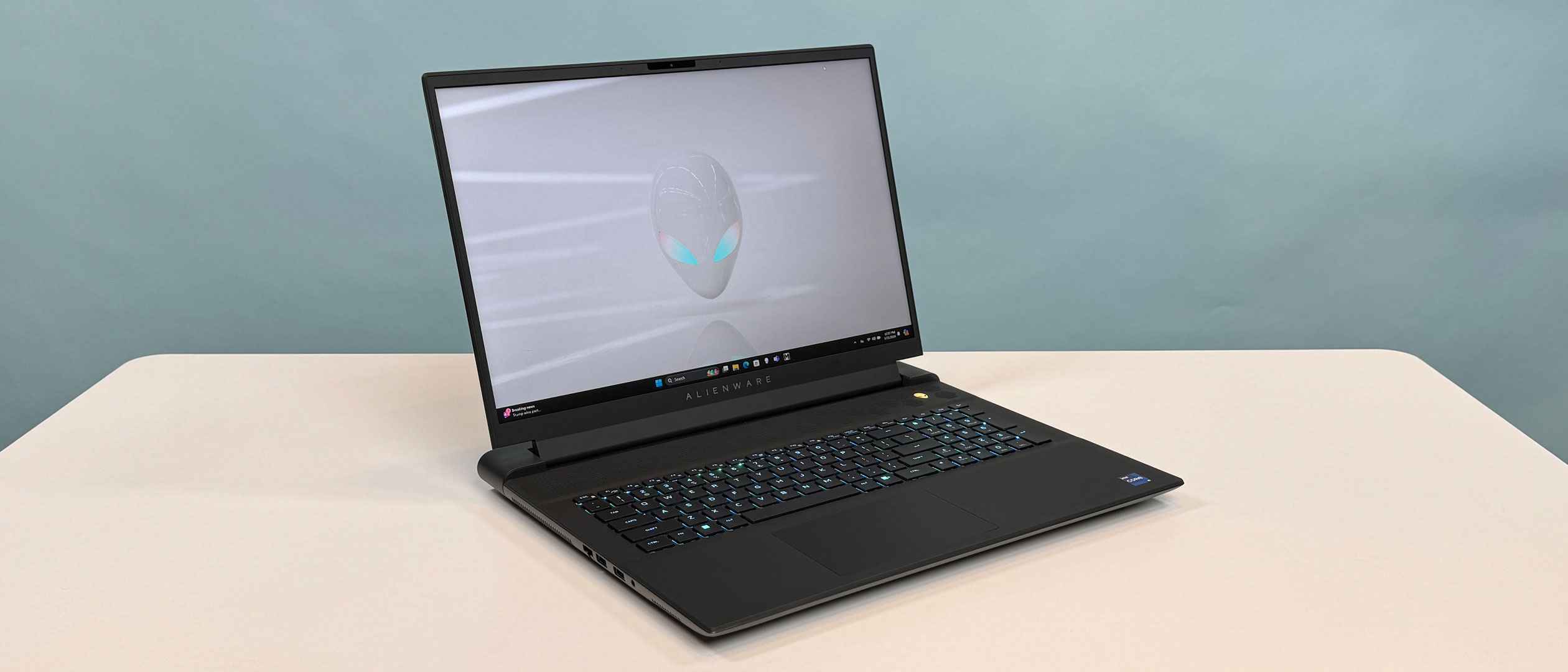
Specifications
Reasons to buy
Reasons to avoid
If you get an 18-inch laptop, it's likely a semi-permanent fixture on your desk. The Alienware m18 R2 is good for that, as it's pretty heavy at 8.63 pounds, but it also delivers strong gaming performance on a large, high-resolution display.
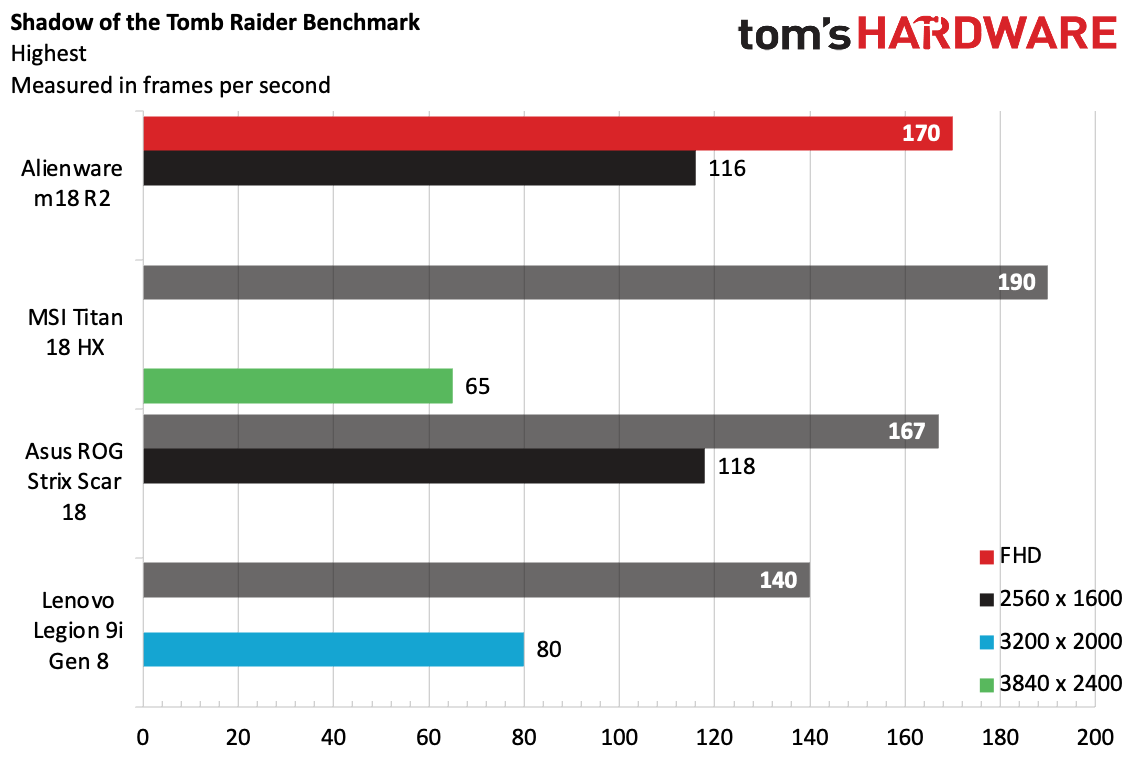

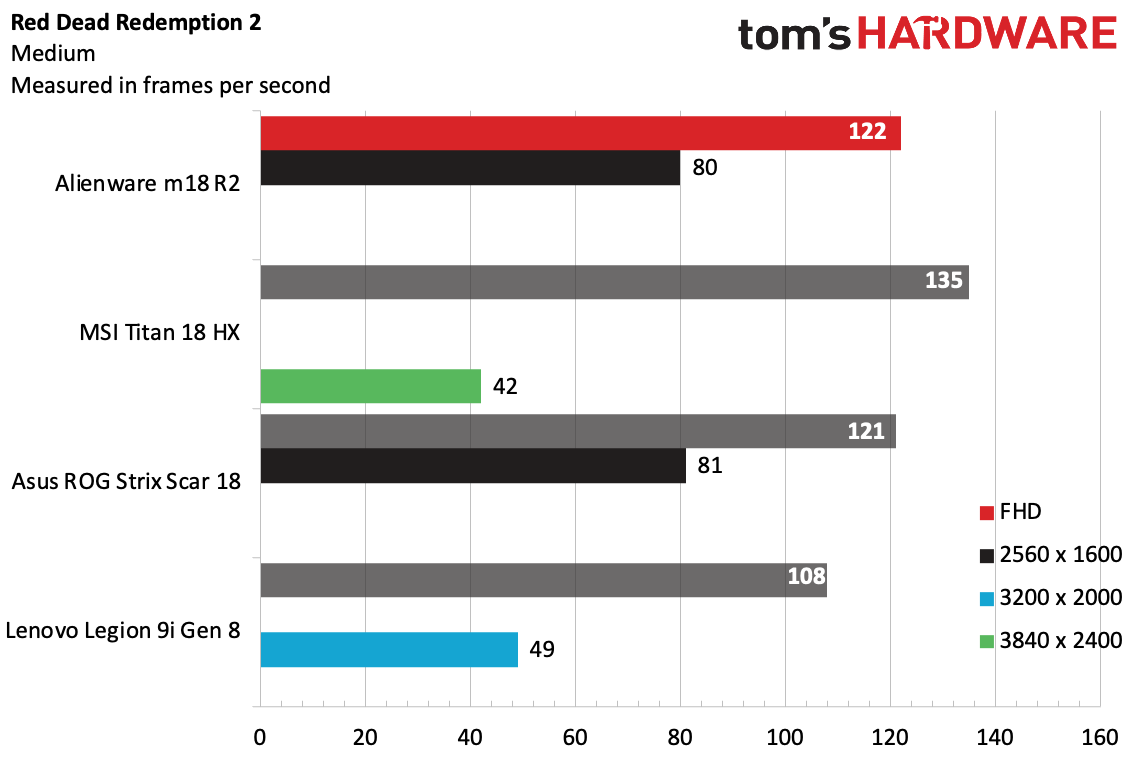
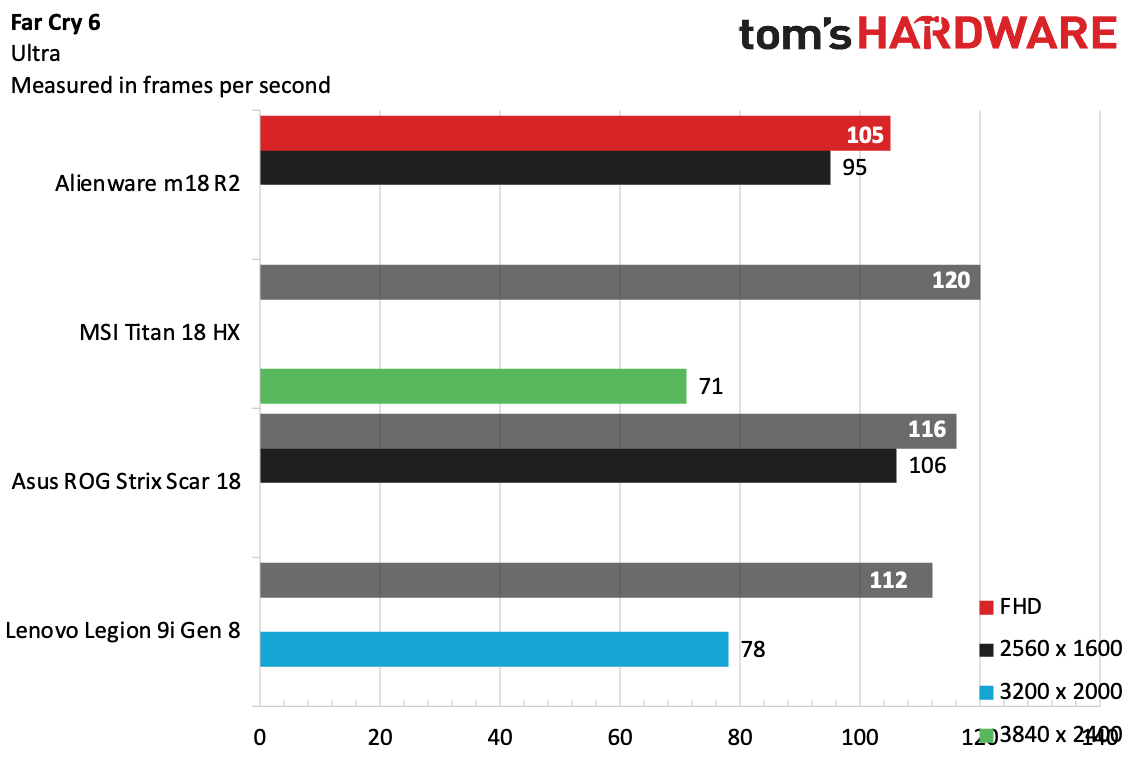
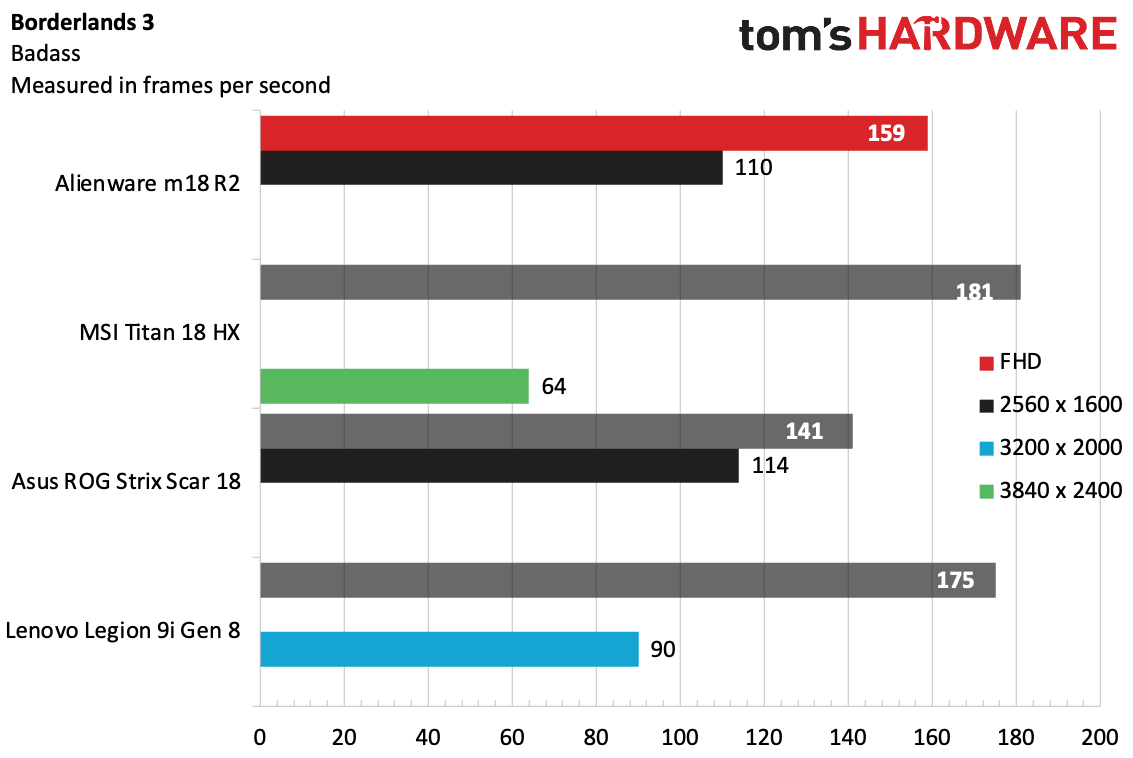
While a gaming laptop won't compete with a desktop for upgradeability, the Alienware m18 R2 is still impressive. When we opened it up, we found a slew of extra slots for M.2 SSDs, as well as slotted RAM, a replaceable Wi-Fi card, and, of course, the battery.
The laptop is built solid, with plenty of aluminum along the frame (though that may be part of what makes it a bit heavy). Perhaps our favorite part is the Cherry MX low-profile mechanical keyboard, which is excellent for both typing and gaming. It's worth the $50 upcharge, and I wish all sorts of laptops had mechanical keyboard options. Unlike the MSI Titan, Alienware's mechanical keyboard covers every key.
That's not to say we have no qualms. The display, while usable, isn't as bright as some of the OLED options out there. And while you're likely using a gaming mouse, the touchpad could use some love. But the build quality, performance, and upgradeability still make this one a winner in our book.
Read: Alienware m18 R2 Review
Best Crossover Productivity/Gaming Laptop

Specifications
Reasons to buy
Reasons to avoid
Many laptop companies have aimed to make gaming machines that look more like traditional PCs while still maintaining a bit of personality. These crossover laptops have often been lower on power, but we found that the Alienware m16 R2 offered strong gaming performance alongside its relatively muted design.
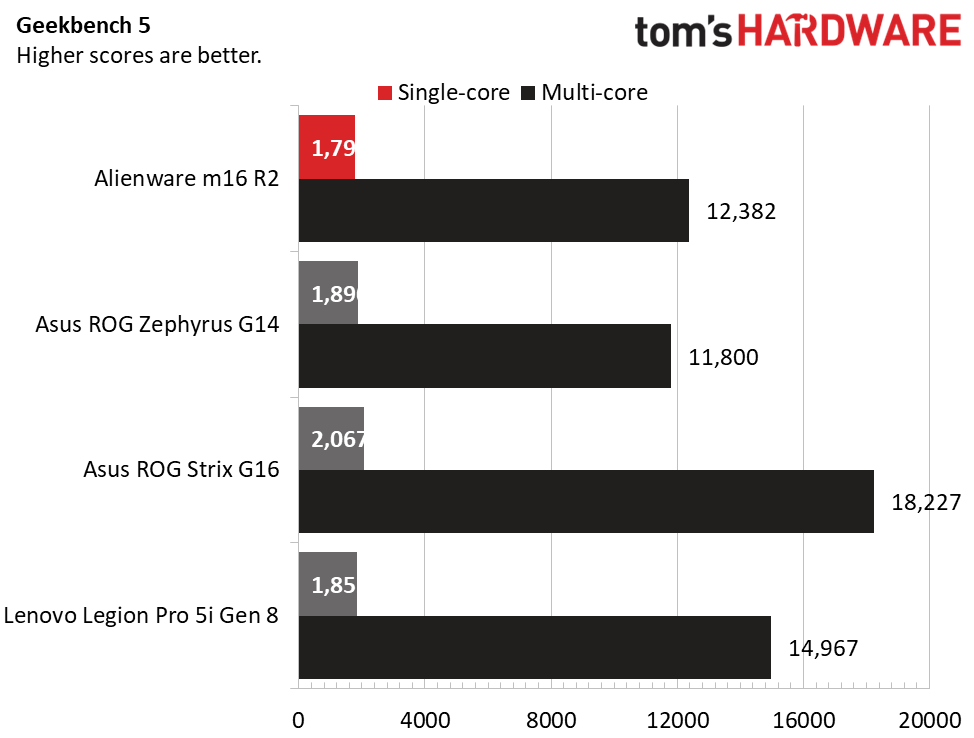
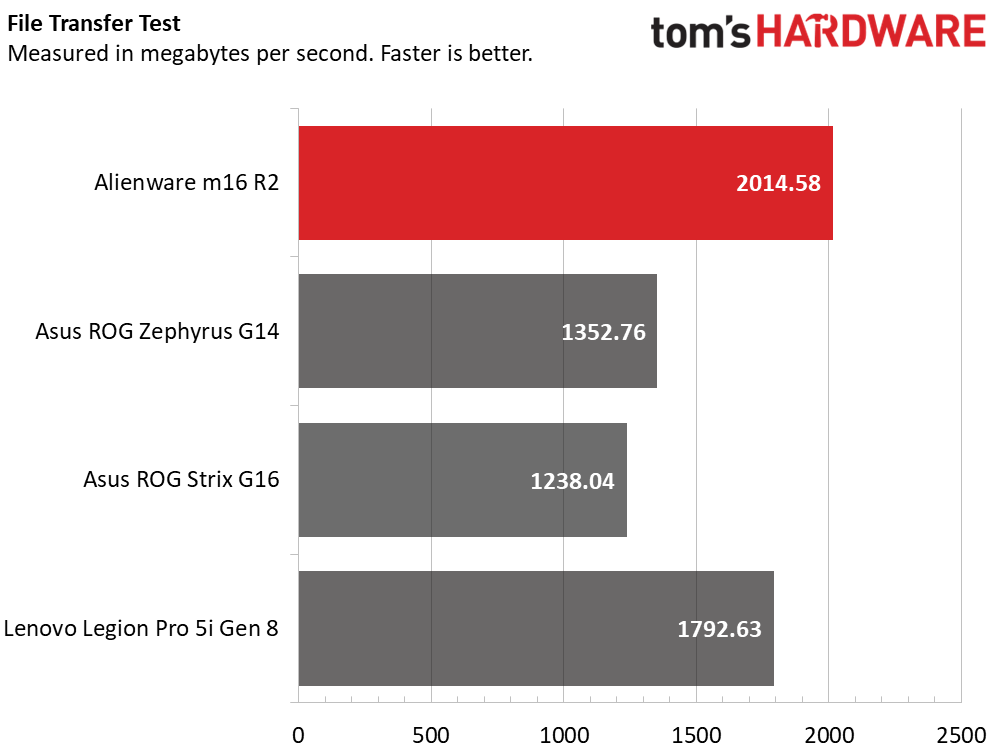
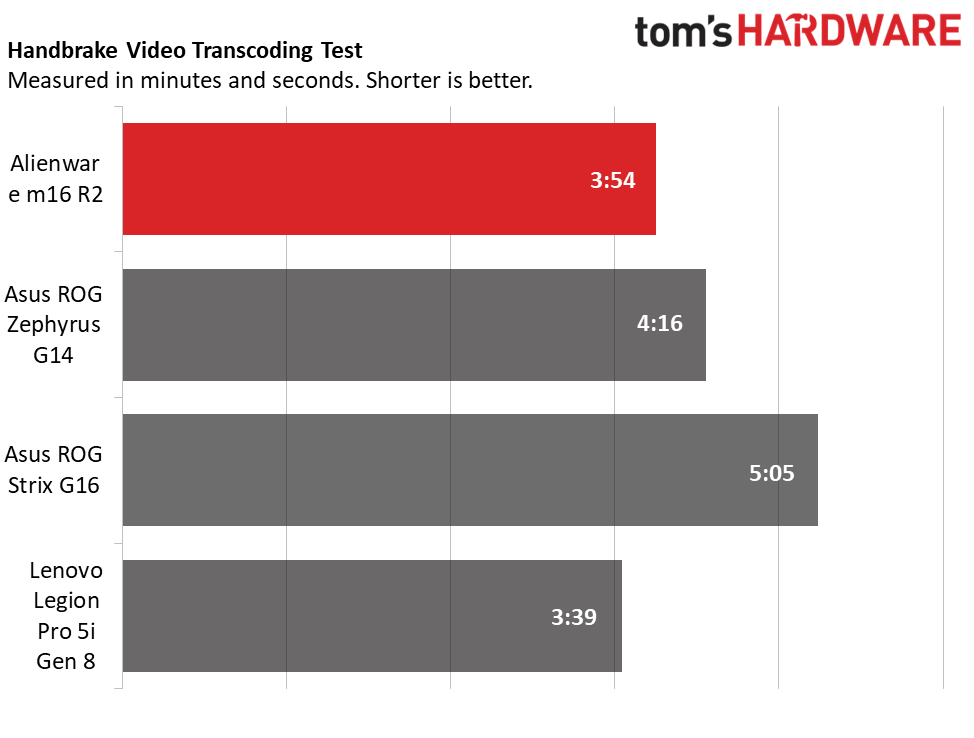
We were impressed with the build quality, including the frame but also the keyboard and touchpad, which we found comfortable to use in our testing.
Additionally, the m16 R2 has plenty of aftermarket upgradeability. When we opened the machine up, we were happy to see that the RAM, SSD, Wi-Fi card, and battery are user-serviceable.
We do wish the display were a bit brighter and that Alienware would bring the price down on the most entry-level models, but in general, this is a well-built machine for work and play. It looks good just about anywhere.
If you want something smaller, we also tested the Asus ROG Zephyrus G14 and the HP Omen Transcend 14, but we preferred the is larger PC because it delivers more graphics power.
Read: Alienware m16 R2 review
How We Test Gaming Laptops
How we test gaming laptops
Every gaming laptop that we review goes through a rigorous series of tests and benchmarks to decide whether it's worth your consideration.
Currently, games that we run and may include in our reviews are:
Game | Preset |
|---|---|
Shadow of the Tomb Raider | Highest |
Grand Theft Auto V | Very High |
Cyberpunk 2077 | Ray Tracing Ultra |
Far Cry 6 | Ultra |
Red Dead Redemption 2 | Medium |
Borderlands 3 | Badass |
We also run a stress test, which currently consists of the Metro Exodus benchmark on the RTX preset, run 15 times in a loop while recording system statistics with HWInfo. (This is also when we take our heat tests).
Additionally, we run a series of productivity benchmarks, including Geekbench, Handbrake, and our in-house file transfer test. These test both single-core and multi-core performance on the processor, as well as all-around performance.
We measure gaming laptop displays with our colorimeter and light meter, and report brightness in nits, as well as the volume of the DCI-P3 and sRGB color gamut that the screen covers.
Our battery test connects to a local web server over Wi-Fi, and continuously browses the web, runs simple OpenGL graphics tests, and streams videos. We report the amount of time the laptop ran the test in hours and minutes.
Benchmarks aren't everything. We also actually use the gaming laptops that we review. Our writers and editors spend time playing games and using gaming laptops for writing, watching videos, listening to music, and browsing the web. This gives us the experience to report our own thoughts and feelings about the keyboard, design, port selection, audio, and other features. It also helps us get some valuable play time in!
Because the ability to upgrade and repair gaming laptops is essential, we open every system to see which parts are user-replaceable and document that experience so you know what you can change down the line and how difficult (or easy!) that is for you to do..
Gaming Laptop Shopping Tips
Quick Gaming Laptop Shopping Tips
- Focus on the GPU: Most games are heavily dependent on the GPU, and those aren’t upgradeable. If you splurge on a powerful GPU now, you’ll be gaming comfortably for a few years.
- You can upgrade some parts later: While the best CPUs for gaming and GPUs are almost always soldered down, most gaming laptops let you replace the RAM and storage, so you can buy cheaper now and add more memory and a bigger best hard drive or SSD down the road. Thicker, more powerful laptops are often easier to upgrade than thinner ones, so be sure to do some research before buying. (We include this information in our reviews).
- Battery life will probably be bad: Very few gaming notebooks get 8 hours or more on a charge, and you need the power supply to get the best gaming performance anyway. However, we've seen some strong times from AMD's Ryzen processors, and Nvidia suggests its improved Optimus technology may help turn the tide. For peak gaming performance, however, you'll want to be sure to be plugged in while playing.
- Get enough storage for your games: Video games take up more storage than ever, and premium gaming laptops are expensive. Shy away from anything less than 512GB. 1TB is the sweet spot and 2TB is ideal for a gaming laptop. Luckily, most machines let you add more storage down the line if you need it.
Discounts on the Best Gaming Laptops
Whether you're shopping for one of the best gaming laptops or another model that didn't quite make our list, you may find some savings by checking out our lists of Dell coupon codes, HP coupon codes, Lenovo coupon codes, Razer promo codes or Newegg promo codes.
MORE: How to Buy a Gaming Laptop
MORE: Best Gaming PCs
Stay On the Cutting Edge: Get the Tom's Hardware Newsletter
Get Tom's Hardware's best news and in-depth reviews, straight to your inbox.
Andrew E. Freedman is a senior editor at Tom's Hardware focusing on laptops, desktops and gaming. He also keeps up with the latest news. A lover of all things gaming and tech, his previous work has shown up in Tom's Guide, Laptop Mag, Kotaku, PCMag and Complex, among others. Follow him on Threads @FreedmanAE and Mastodon @FreedmanAE.mastodon.social.
-
Ragerokit This article has links to laptops with (deceptively) lower specs than those reviewed ie aorus links to a laptop with only 16gb ram a lot of buyers might miss that sort of change especially when the model number remains the same.Reply
